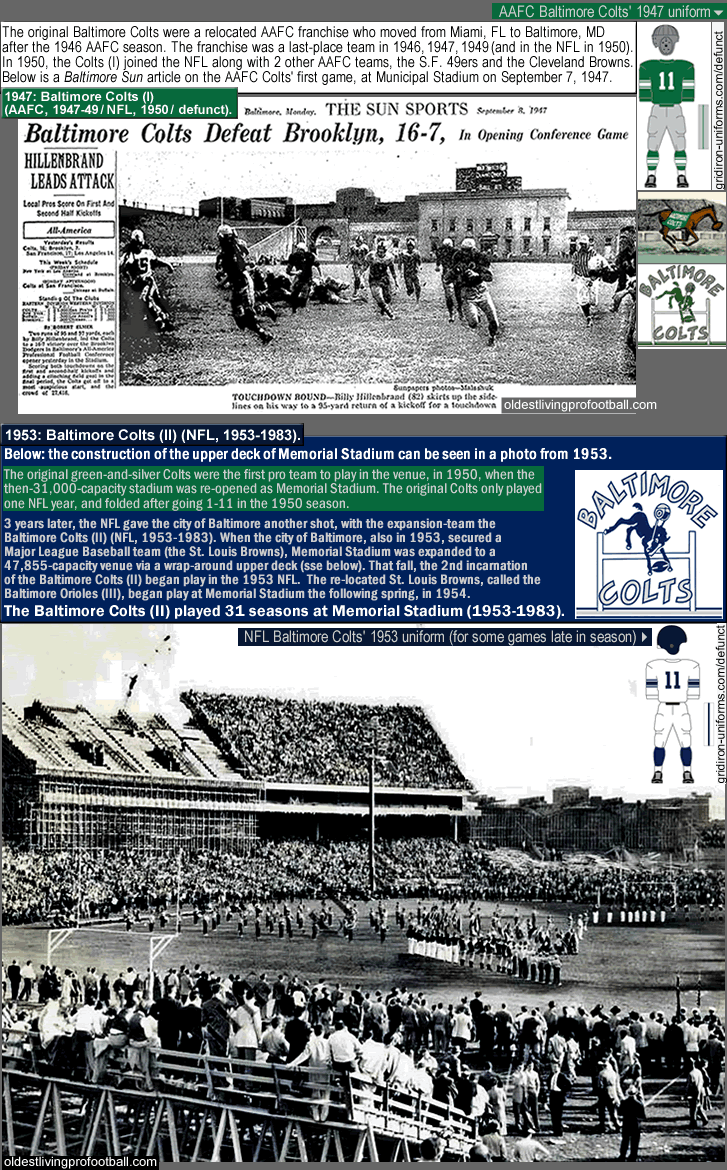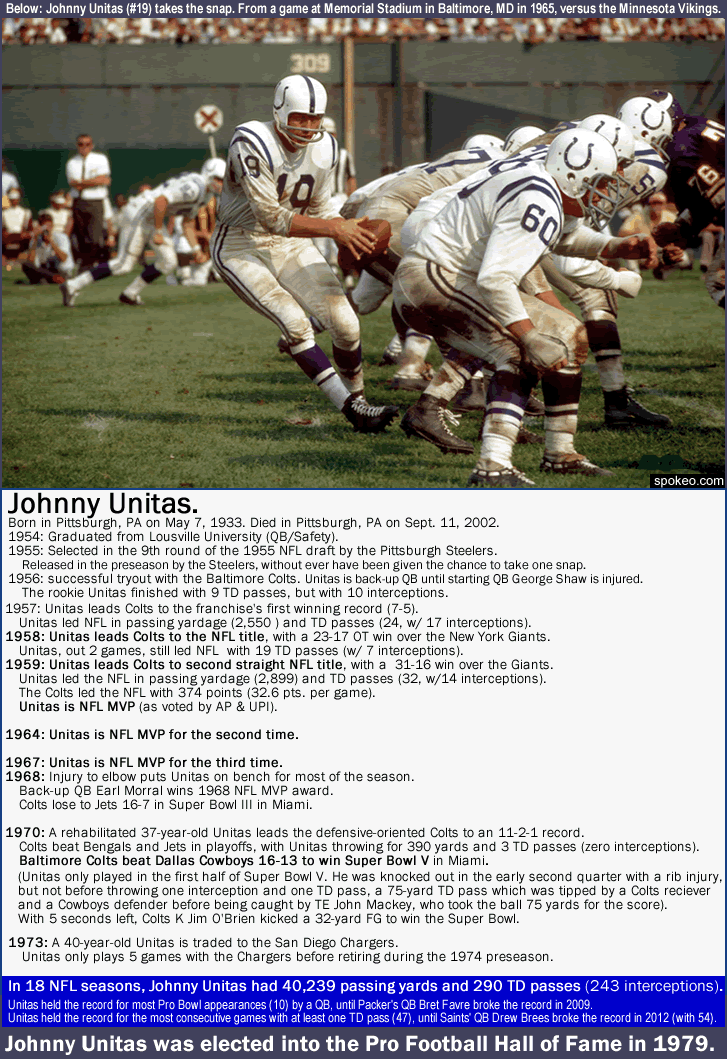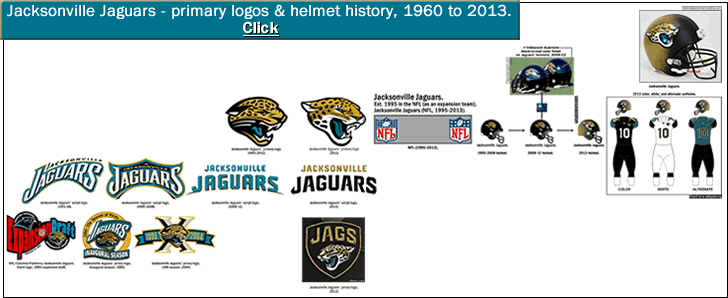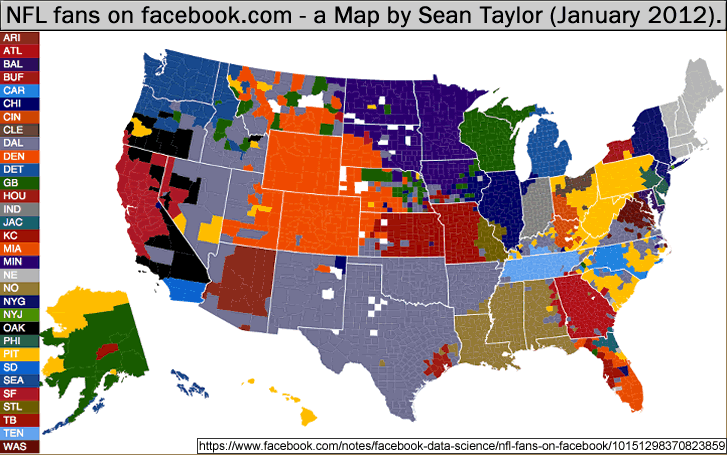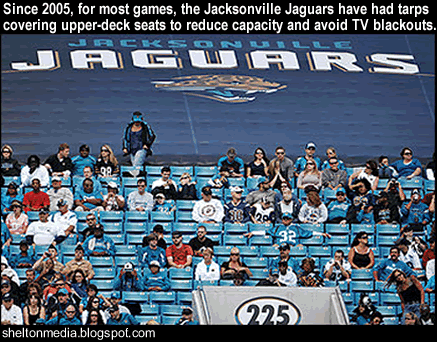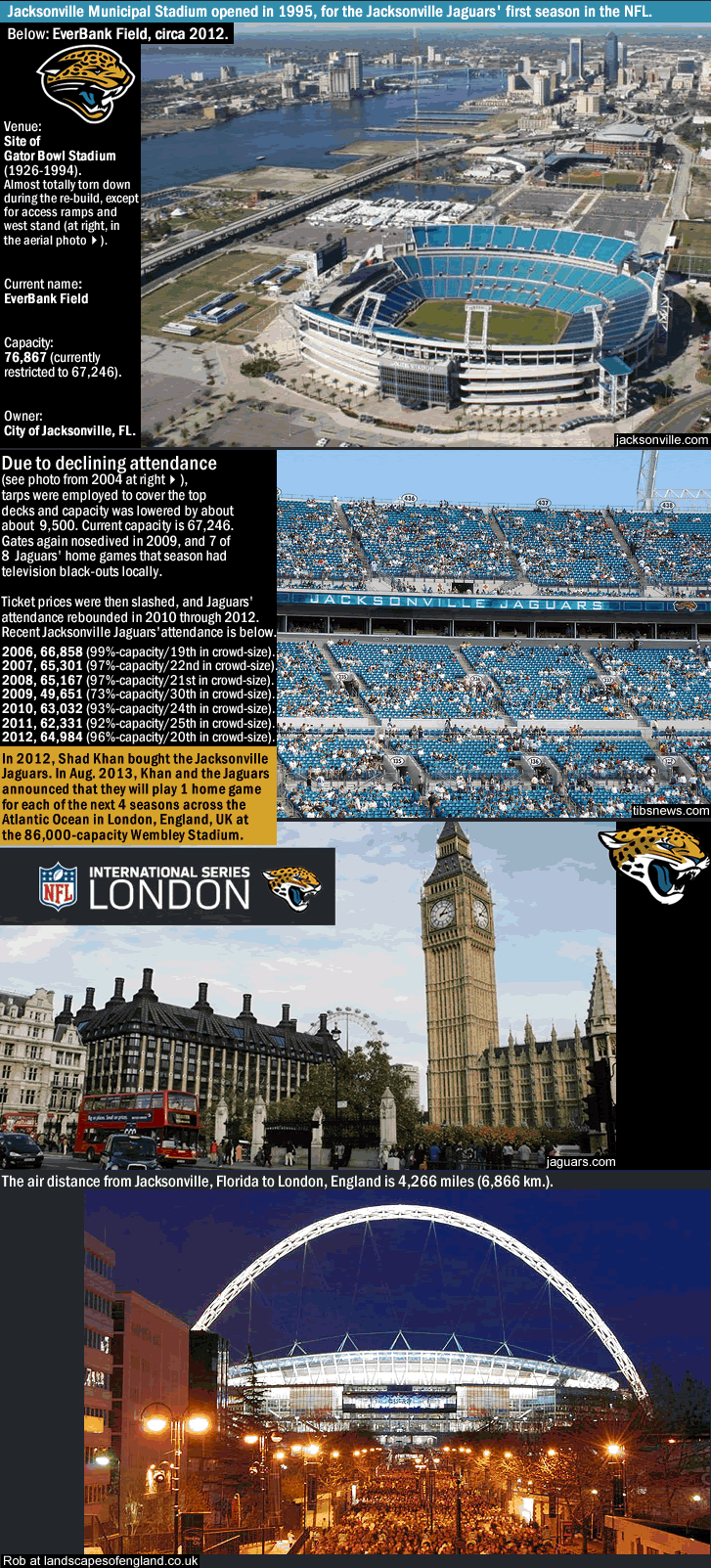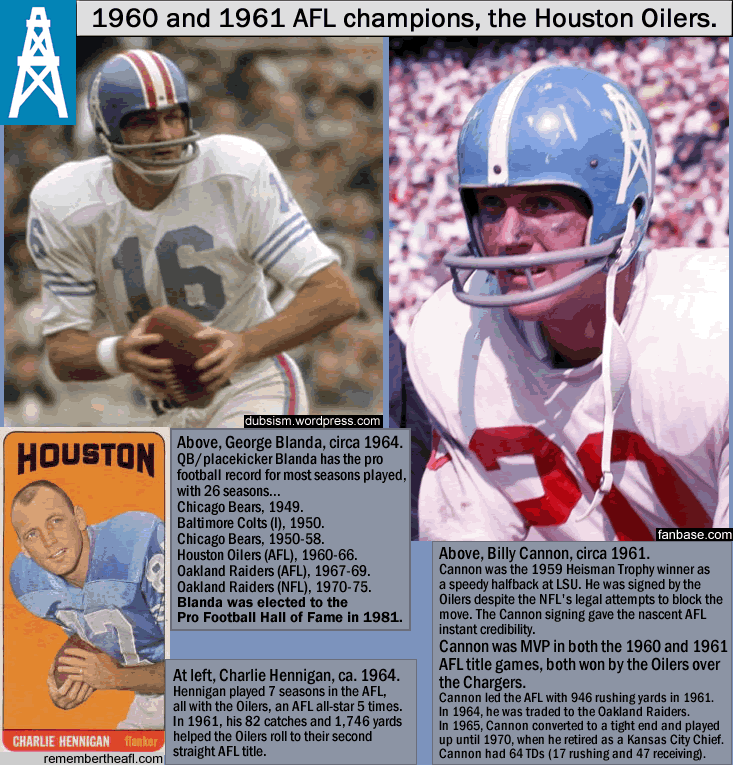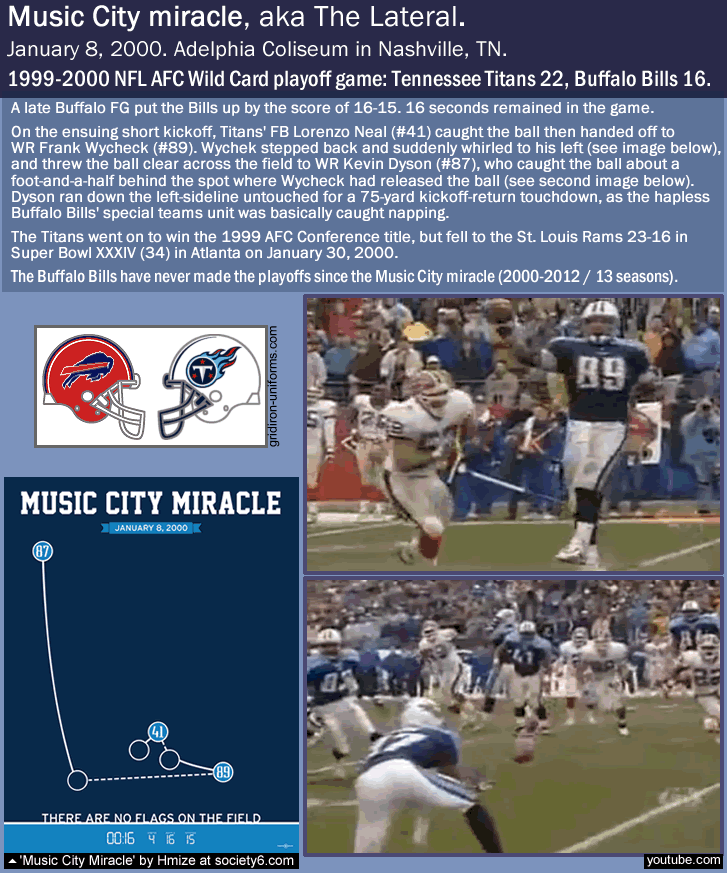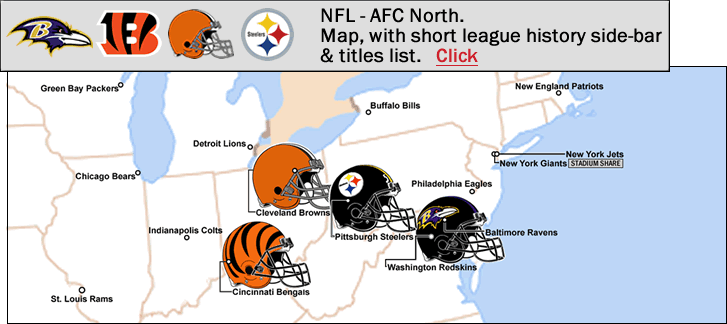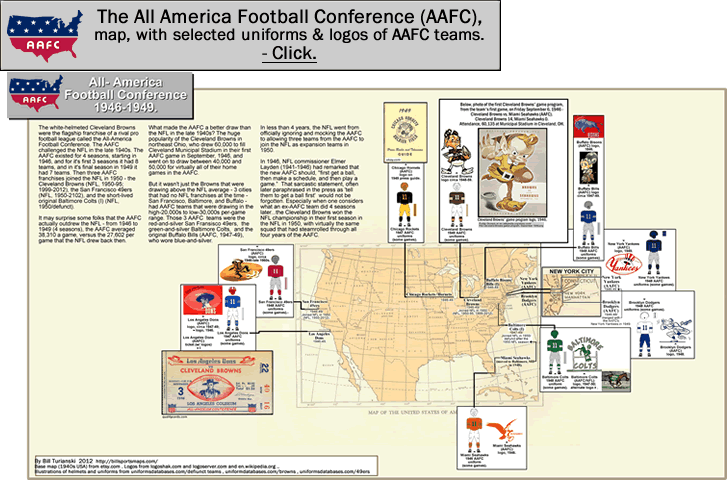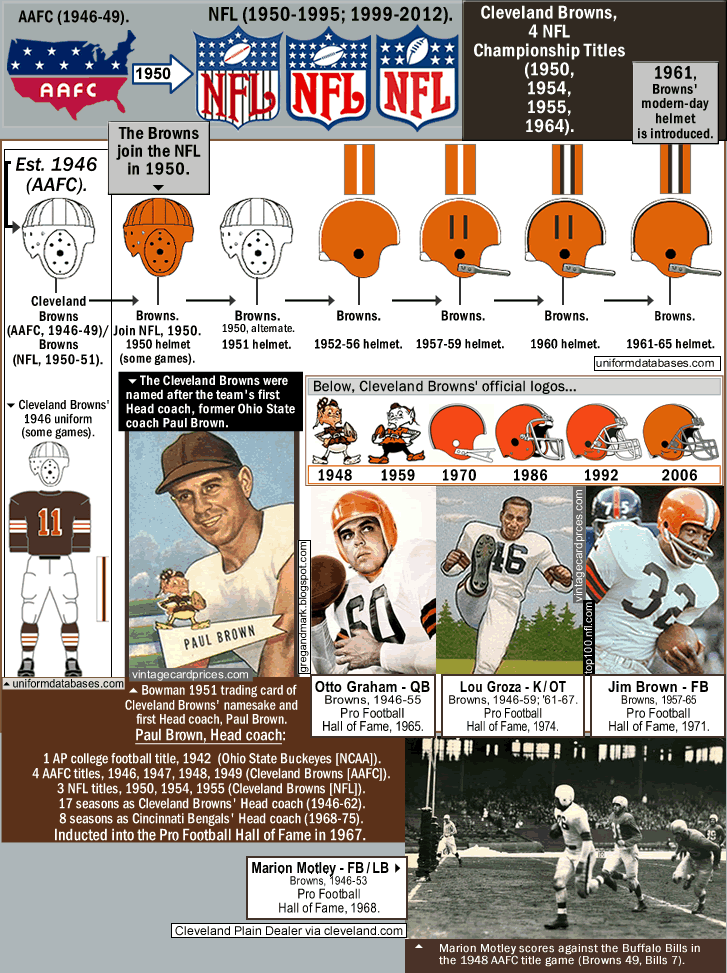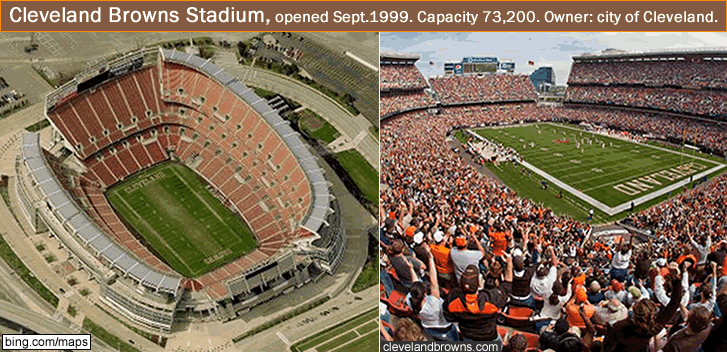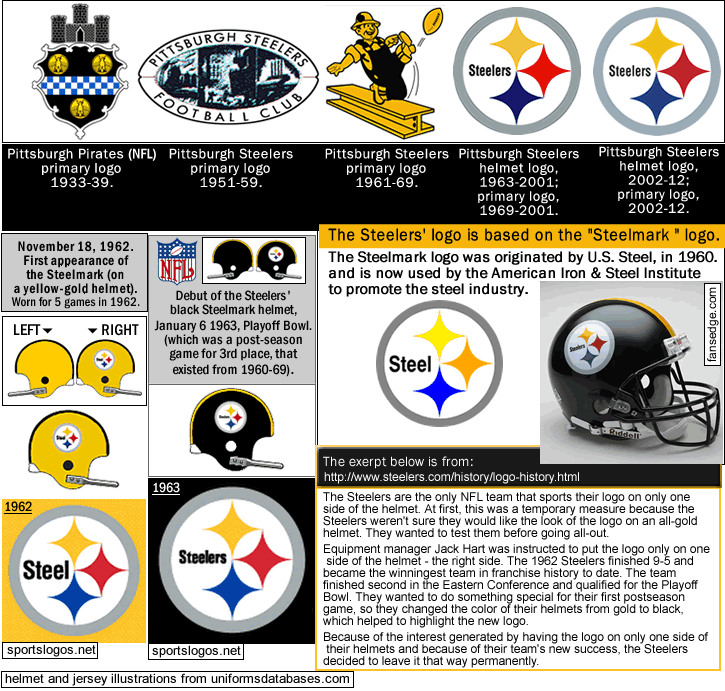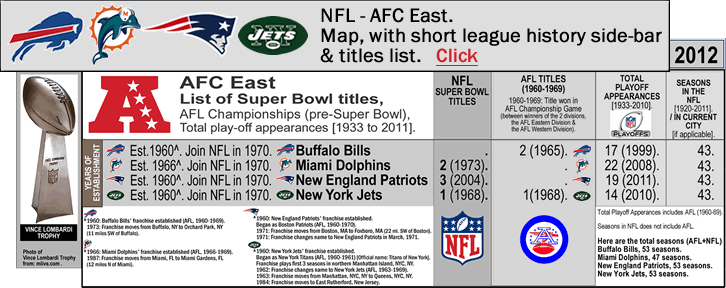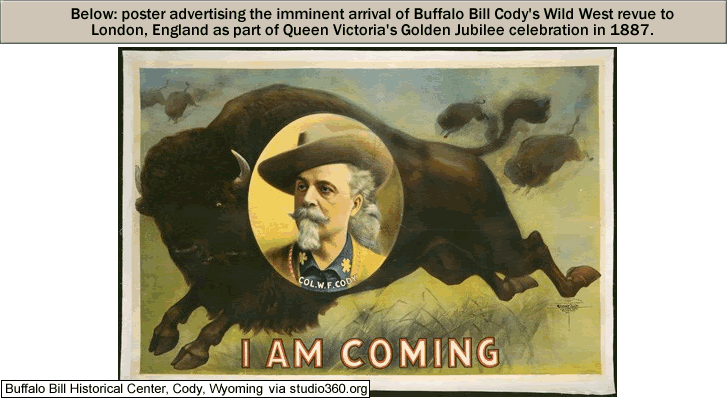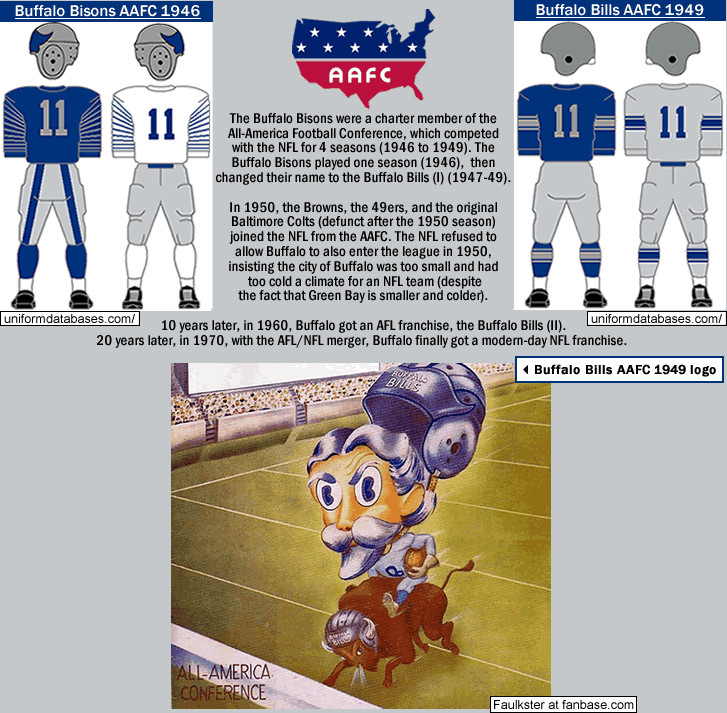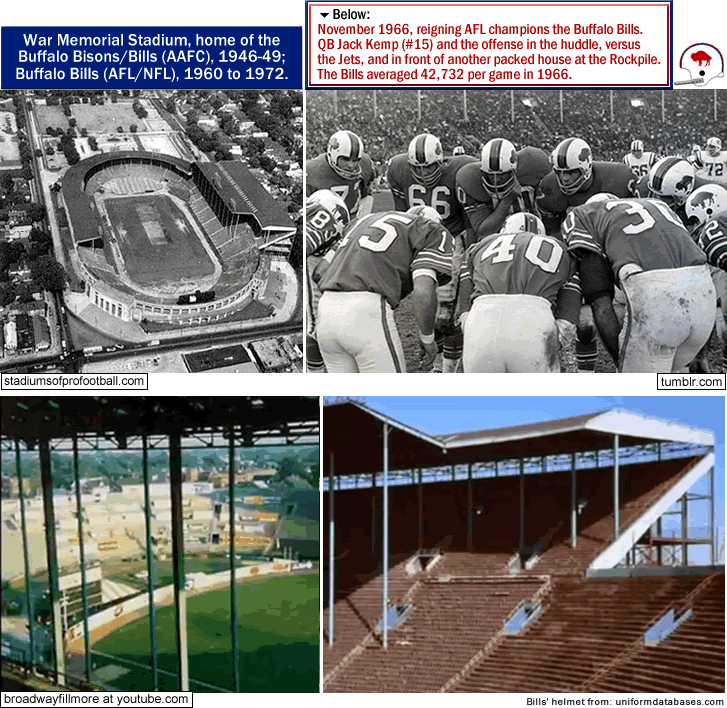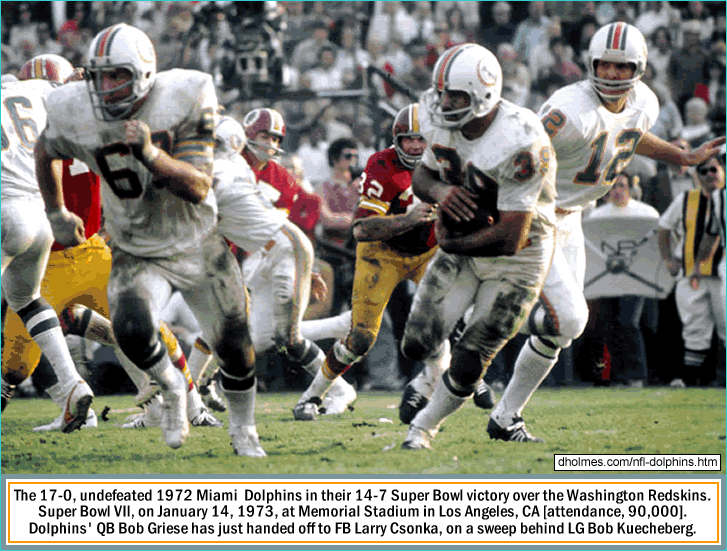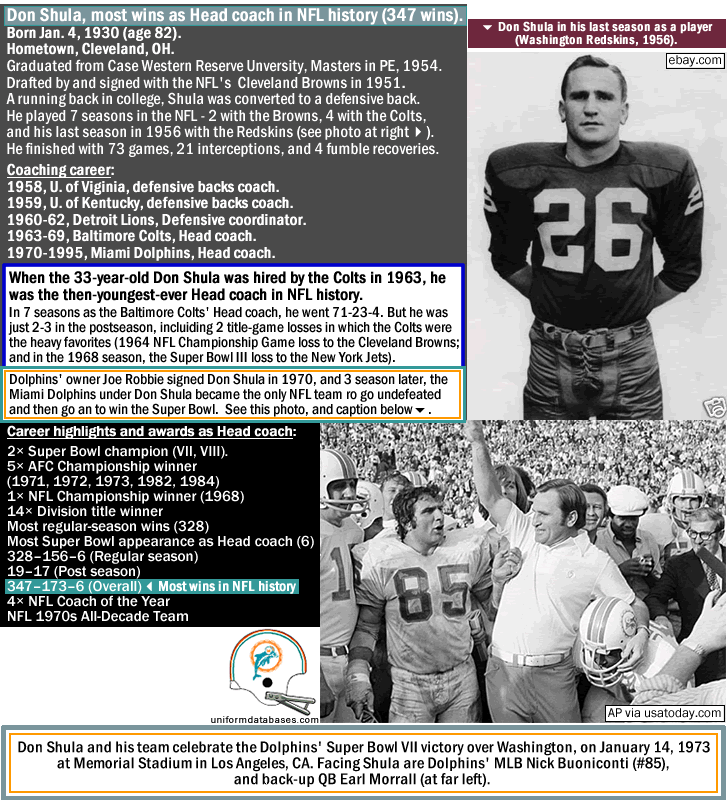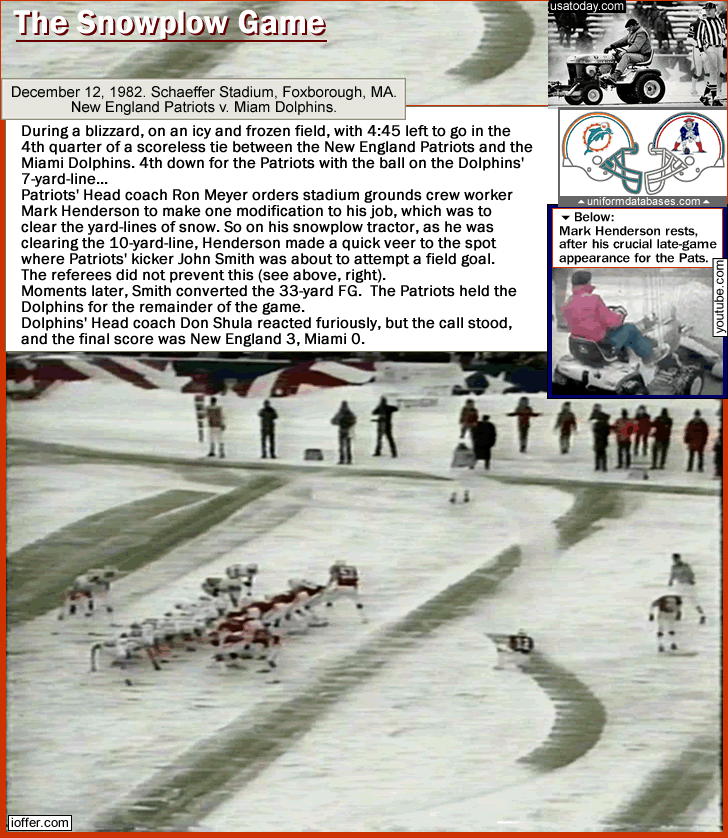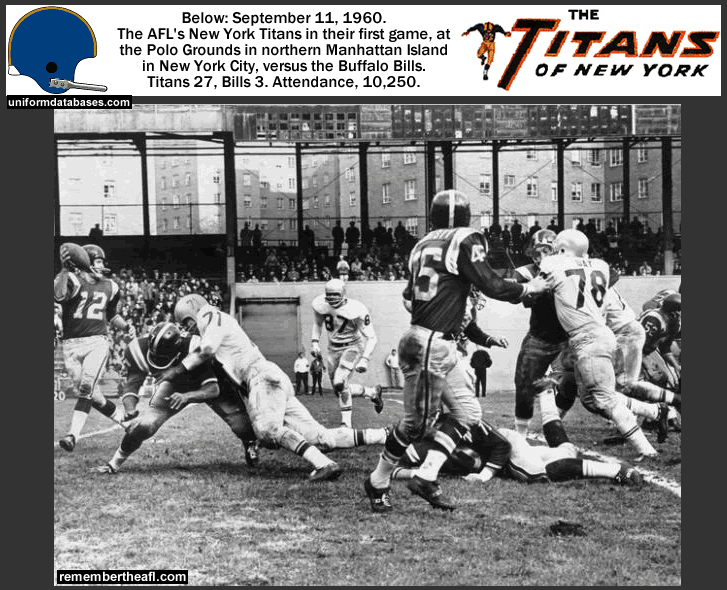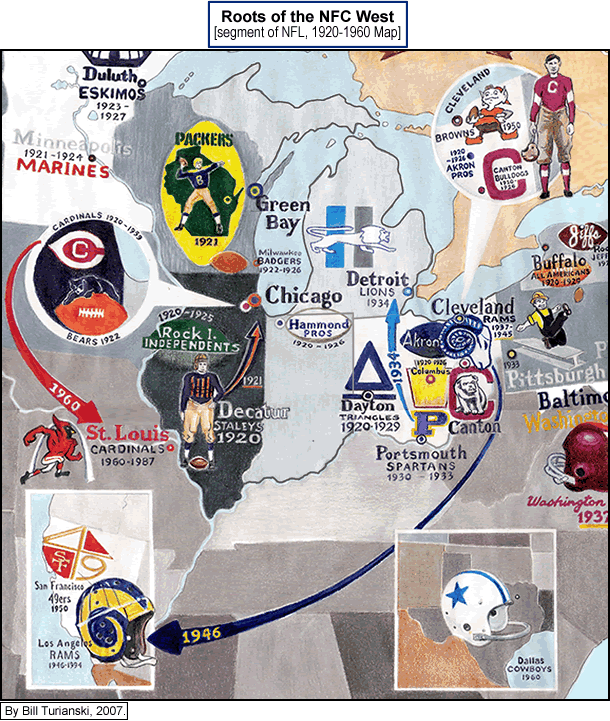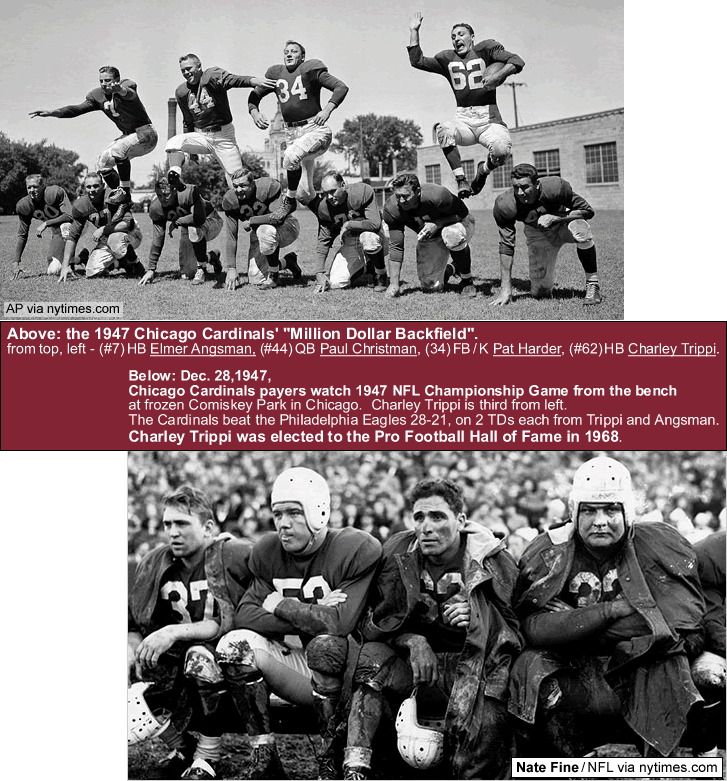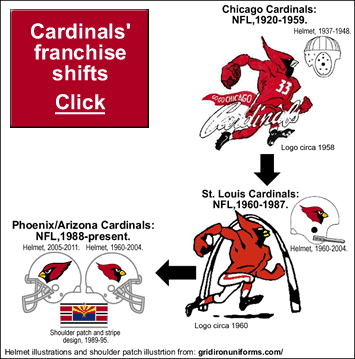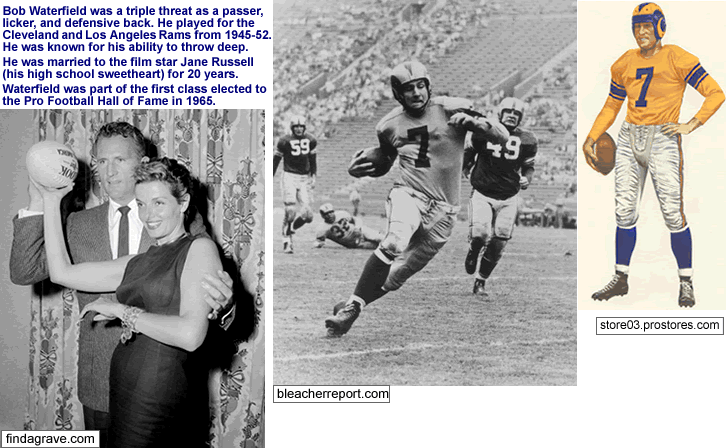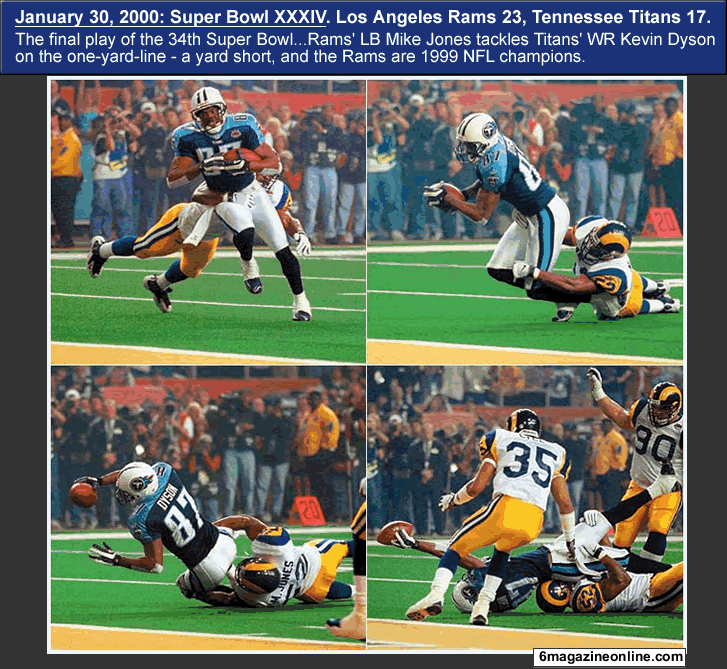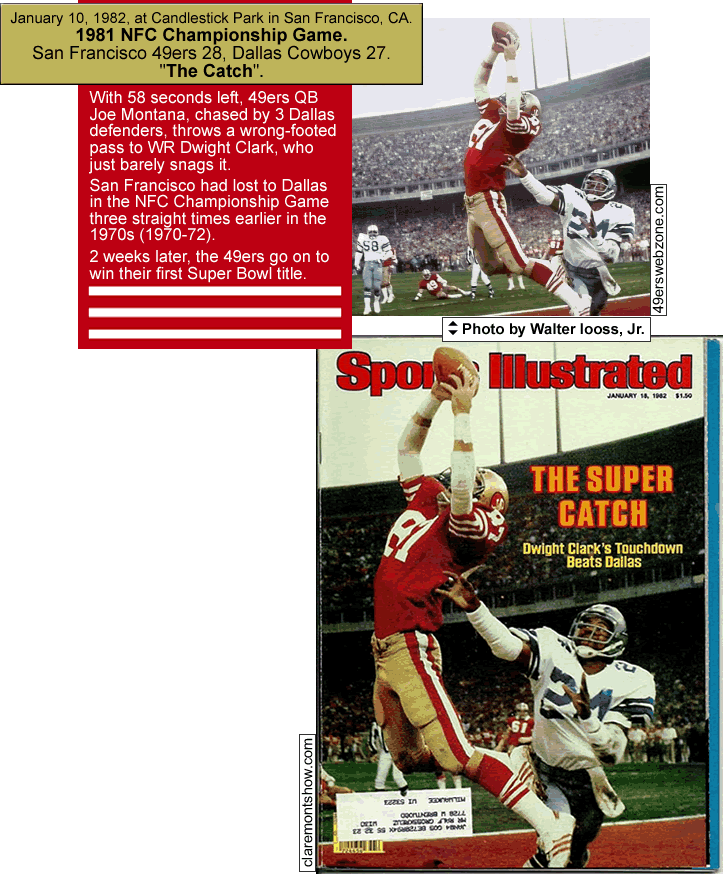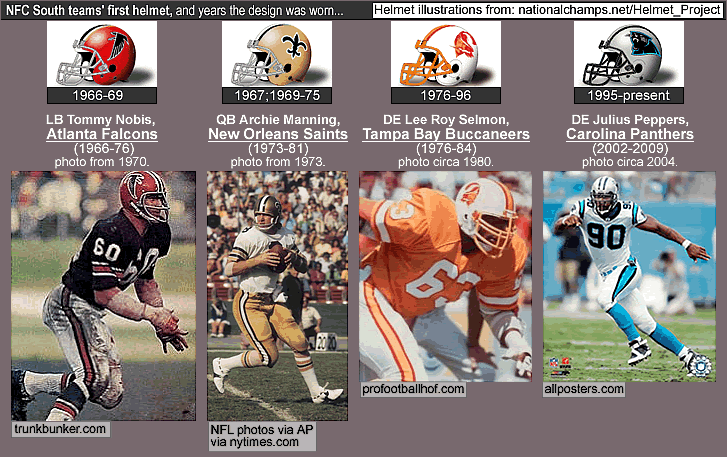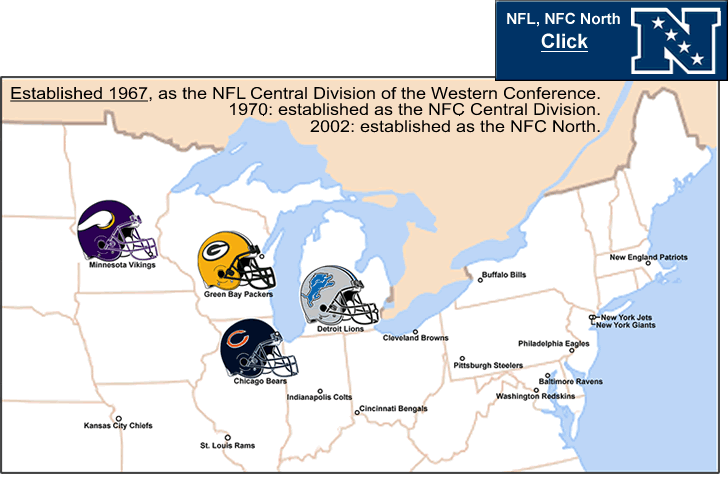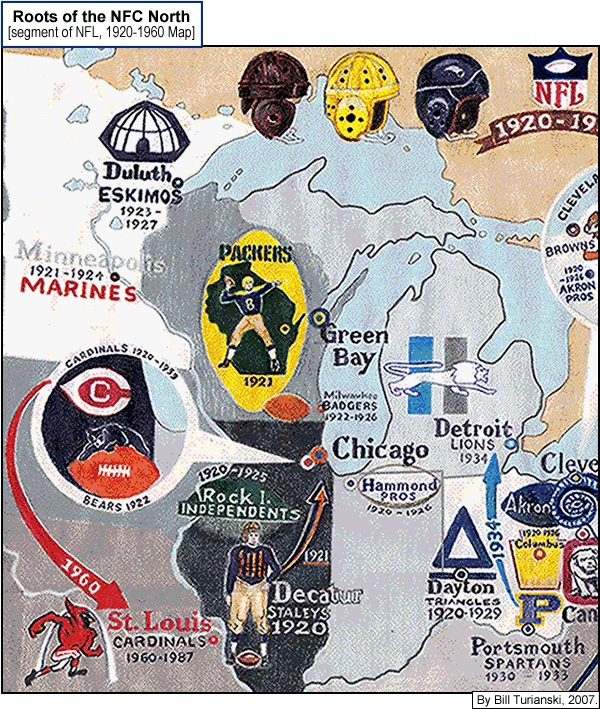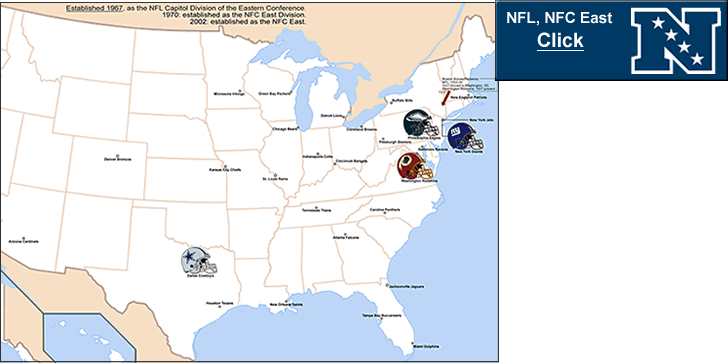…
-
Denver Broncos logos and helmet history (1960-2014), click on image below…

Denver Broncos logos and helmet history (1960-2014)
Broncos helmet illustrations above from Gridiron Uniforms Database. Broncos uniforms png by fma12, en.wikipedia.org/wiki/File:Broncos_uniforms.png. Photo of Broncos’ authentic Riddell helmet, from dickssportinggoods.com.
From May 2009, from the boards at Denver Broncos’ website, uploaded by White Dragon, ‘COMPLETE Denver Broncos Helmet History [1960-2009]‘ (forums.denverbroncos.com).
Origin of Broncos nickname…
A “bronco” is an unbroken or untamed horse, and it is a reference to Denver’s Wild West heritage. The Bronocos nickname came about by being the winning entry of a name-the-new-team contest that the new Denver AFL franchise had in early 1960. The winner (out of only 162 entries) was by Ward M. Vining. There was a previous pro team in Denver with the same name – an Independent minor league baseball club in the 1920s named the Denver Broncos. This makes the name even more fitting because the founder and first owner of the Denver Broncos AFL franchise was Bob Howsam, who was back then also co-owner of the old Triple-A team minor league ball club, the Denver Bears (the Denver Bears were owned by the Howsam family [Bob, his brother Earl, and his father Lee], from 1947-62). The Denver-born-and-raised Bob Howsam’s dream was to bring Major League Baseball to Denver (Howsam also later made his mark as GM of the Cincinnati Reds during their Big Red Machine era of the 1970s). [It took over 3 decades but in the end, Howsam later helped bring the dream of big league ball to the Mile High City when in retirement, he served on the Colorado Baseball Commission, which was successful in bringing about the Colorado Rockies, an MLB expansion team in 1993.]
-
Stadiums the Denver Broncos have played in…
1959: an over-expanded minor league baseball stadium in Denver needs a new tenant…
The aforementioned Denver Bears minor league ball club, in 1959, were playing in a ballpark far too big for even the top tier of the minor leagues (it had been recently expanded to 23,000 and was in the process of being expanded yet again to 34,000, which is about double the size of what a Triple-A ball club could reasonably have as a stadium-capacity). This happened because Bears GM/co-owner Bob Howsam, who had led the stadium-expansion-move, had tried to get Denver a team in the never-realized Continental Baseball League, which was an attempt to create a third, rival, Major league in baseball. It never happened because MLB outmaneuvered the Continental League’s organizers by expanding from 16 to 20 teams and placing new franchises in 3 of the primary places the failed-Continental League had targeted (New York City [new franchise with Mets in 1962], Houston [new franchise with Colt 45s/Astros in 1962], and Minneapolis/St. Paul [dual-MLB-franchise shift with Washington Senators (I) moving north to Minnesota to become the Minnesota Twins & new MLB franchise in Washington, DC as Washington Senators (II) [side-note: the fourth expansion team in MLB circa 1961-62 was the Los Angeles/California/Anaheim Angels in 1961]).
So the Denver Bears were saddled with a heavy debt from the re-build, and Howsam knew another team was needed for the venue or it would become a White Elephant and drag down his Denver Bears and his dream of Major League Baseball in Denver with it. A few years earlier (circa 1958), Howsam had already tried to buy the NFL’s Chicago Cardinals and move them to Denver. There were three others who also had, in the late 1950s, tried to buy-and-move the struggling Chicago Cardinals to their cities. They were Lamar Hunt (of Dallas), Bud Adams (of Houston), and Max Winter (of Minneapolis/St. Paul). Howsam would go on to become a founding owner of an AFL team in Denver in 1960, along with AFL creator Hunt (the leagues’ founder and founder/first owner of the Dallas Texans (II)/Kansas City Chiefs franchise) and Adams (who was the founder/first-owner of the Houston Oilers/Tenessee Titans franchise). [Winter would go on to be co-founder/first-co-owner of the Minnesota Vikings NFL franchise in 1961.] But, possibly aside from the Oakland AFL franchise, Howsam’s Denver Broncos franchise was the most under-financed in the new rival league in 1960. The penny-pinching ways of the early Denver Broncos became legendary (see illustration further below, and see the colors and logos section further below). Mounting debt forced Howsam to sell the Broncos in early 1961. He sold the Broncos to a consortium that had Gerald Phipps as the main shareholder [Phipps was owner of the Broncos from 1961-81]).
Bears Stadium/Mile High Stadium, home of the AFL’s Denver Broncos from 1968-69 & home of the NFL’s Denver Broncos from 1970-2000…
The Howsams constructed Bears Stadium in 1947-48 on a rat-infested area west of downtown Denver, on the site of an old city dump. The Denver Bears, who were then in the Class-A Western League (IV), began play there in August, 1948 (and played there for 45 years [later changing their name to the Denver Zephyrs] until they vacated Denver to make way for MLB’s Colorado Rockies and moved after the 1992 season to New Orleans as the still-in-existence New Orleans Zephyrs).
Bears Stadium, upon opening in August 1948 had a 17,000-capacity and was a single V-shaped bleacher stand built into the side of an existing hill there. In the illustration below, you can see how Bears Stadium looked in 1954 (the last year the Denver Bears were a Class A team; they moved a couple steps up the minor-league-ladder the following season in 1955 when they joined the Triple-A American Association). Circa 1957-59, when Bob Howsam tried to get a big-league-ball-club in the Continental League, capacity was increased to 23,000 (and the intention was to continue the expansion). When the Continental League never came to be, Howsam turned his attention to finding another tenant besides his Bears for the debt-laden stadium, and once the AFL franchise for Denver was secured by Howsam in the summer of 1959, the stadium expansion continued. The Denver Bears’ ballpark (the venue that would later be known as Mile High Stadium), was expanded to 34,000 prior to the Broncos’ AFL home debut in September, 1960. In 1968, after the stadium was bought by the City of Denver (from the second owner of the Broncos, Gerald Phipps), capacity had been expanded to 50,000 with the installation of the South Stand.
Below: an illustration featuring photos of Broncos’ Stadiums (and the precursor-stadium), and some of the more interesting gear worn by the team… 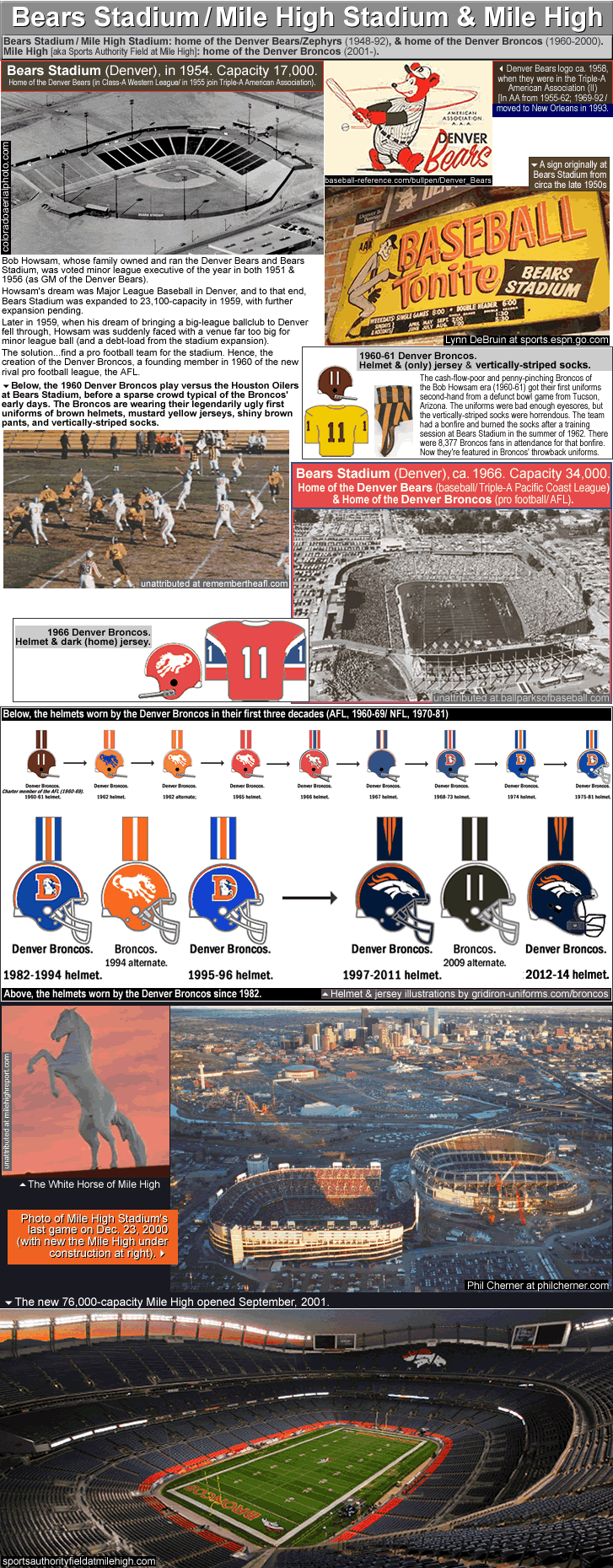
Photo and Image credits above – Black and white aerial photo of Bears Stadium 1954, by coloradoaerialphoto.com. Denver Bears logo ca. 1955, from baseball-reference.com/bullpen/Denver_Bears. Photo of Denver Bears’ exterior-stadium-sign circa late 1950s, by Lynn DeBruin at Denver’s own Field of Dreams [at sports.espn.go.com]. Color photo of Broncos versus Oilers from 1960, unattributed at remembertheafl.com/Broncos. Black-and-white photo of Mile High Stadium circa mid-1960s, unattributed at ballparksofbaseball.com/past/MileHighStadium. Illustration of Broncos’ dreaded brown-and-yellow-vertically-striped socks from remembertheafl.com/Broncos. Broncos helmet and jersey illustrations from gridiron-uniforms.com/broncos. White Horse sculpture at Mile High, photo unattributed at milehighreport.com. Aerial photo of Mile High Stadium’s last game on Dec. 23, 2000, photo by Phil Cherner at philcherner.com. Sports Authority Field at Mile High, photo by sportsauthorityfieldatmilehigh.com.
The Denver Broncos, initially saddled with the crushing debt that forced Howsam to sell the team in early 1961 after one season, never got their footing in the AFL, and never made the playoffs (nor had a winning season) in the AFL’s 10 seasons, and finished 39–97–4 in the league. Attendance was understandably poor for the first few seasons. The Broncos drew only 13,047 in 1960 when they finished 4-9-1; and they drew even worse the next year in 1961 at just 10,644 per game, when they finished 3-11. In 1962, new head coach Jack Faulkner helped improve the team, and improve the struggling team’s fan base, when the Broncos went 7-7 and drew 25,498 per game. And even though the Broncos got bad again the next few seasons, and even though attendance fell below 20K per game for a couple years, by 1965 the Broncos were drawing above 30K per game. And when the city of Denver bought Bears Stadium and renamed it Mile High Stadium in 1968 (and began another stadium expansion to 50,000), the Broncos surpassed the 40K per game mark…and their attendance has been healthy ever since. {source of AFL attendance figures (1960-69): THE AMERICAN FOOTBALL LEAGUE – ATTENDANCE, 1960-69, by Bob Carroll at profootballresearchers.org/Coffin Corner Vol. 13, No. 4 (1991) [pdf]}.
And when the Broncos joined the NFL in 1970, as part of the AFL/NFL merger, the Broncs sold out every game that season. With the exception of the replacement-players games in 1987, every Denver Broncos home game in the NFL (1970-86; 1988-present) has been sold out (!).
So, basically, the Broncos developed a strong fan-base despite the fact that the Broncos never had a winning season until 1973. In fact, the Broncos never made it to the playoffs until their run in the 1977 NFL season, when, coached by Red Miller, led by aging QB Craig Morton [1977 Comeback Player of the Year], bolstered by their Orange Crush defense, and spurred on by their loud and raucous fans at Mile High Stadium, the 12-2 Broncos went all the way to Super Bowl XII [12] in January 1978, losing to the Cowboys 27-10.
Another expansion took place at Mile High Stadium from 1975–1977. This raised the capacity to 75,000. The main component of this expansion was a movable, triple-decked stands along the east side, which when fully retracted toward the field, formed a horseshoe for Broncos’ home games. For Bears’ baseball games, the new movable stands were fully extended by 145 feet, so that the stadium could still fit a normal-sized baseball field.
Mile High – opened 2001 (a stadium originally called Invesco Field at Mile High; now called Sports Authority Field at Mile High)…
The Broncos played in Mile High Stadium until 2000. By the late 1990s it was becoming obvious that the stadium was outmoded, and so plans for a new stadium began. The stadium was to be paid for primarily by a sales tax scheme in the 7-county Greater Denver region (in the 1998-2011 time period), and that tax scheme expired when both the new football stadium for the Broncos, and the new baseball stadium for the expansion MLB team the Rockies, were all paid for (the sales tax to fund the stadiums expired on Dec. 31, 2011). Here is an article on that rather efficient-and-not-too-onerous tax scheme that got Denver 2 new major league sports stadiums, Tax off books, but not registers (denverpost.com article by Chuck Murphy from Jan. 27, 2012). The new Mile High opened on September 10, 2001. Its capacity is 76,425 for football. It is owned and operated by the Denver Metropolitan Football Stadium District.
…
-
1997-98 Denver Broncos: back-to-back Super Bowl champions…
Broncos end AFC’s 13-year title drought…
{Note: see this list for reference for the following two paragraphs: Super Bowl Championship (1966–present) (en.wikipedia.org).}
The AFC’s 16 members include all 10 AFL franchises that merged with the NFL in 1970. The AFL won two of its four games ever played against the NFL (Super Bowls I-IV). Then the AFL’s evolution into the American Football Conference saw that entity dominate the early years after the AFL/NFL merger (1970-80 seasons), winning 9 of first 11 Super Bowl titles after the merger. Because the following two teams came over from the pre-merger NFL to the new AFC in 1970, when you subtract the Baltimore Colts’ Super Bowl title in the 1970 NFL season and the Steelers’ four Super Bowl titles (1974-75 seasons; 1979-80 seasons), the fact of the matter is that teams that originated in the AFL went 6-wins-and-4-losses in the first 15 Super Bowl match-ups (Jets win in the 1968 season, Chiefs in ’69, Dolphins in ’71 & ’72, Raiders in ’76 & ’80). When you look at it that way it is plain to see that history shows that the AFL had become on par with the NFL by the time of the merger, and a decade later its teams were still the equal-or-better of the old-guard NFL.
But then the old-guard-NFL reasserted itself in the 1980s and into the mid-1990s. The older teams became predominant, and non-AFL teams [all formed before 1961] won 15 of the next 16 Super Bowl titles from the 1981 season to the 1996 season (16 years with 6 teams from the NFC as champions with one exception – the Los Angeles Raiders winning the Super Bowl in the 1983 season). Going into Super Bowl XXXII [32] (on January 25, 1998), the AFC had not won a Super Bowl title in 13 seasons (the 1984 to 1996 seasons). The Denver Broncos changed that. With an aging but still effective John Elway at QB, and with RB Terrell Davis and WR Shannon Sharpe spearheading the offense, coach Mike Shanahan’s Broncos beat the reigning champs the Green Bay Packers 31-24, in a thrilling Super Bowl match-up in January 1998 (Super Bowl XXXII [32]). Then the Broncos repeated by beating the Atlanta Falcons 34-19 (in Super Bowl XXXIII [33]). The tide had turned in the old and still relevant AFL-NFL rivalry, and normal service was restored, so to speak. Since 1997 and up to 2014 it has been: AFC with 10 Super Bowl titles and the NFC with 7 Super Bowl titles.
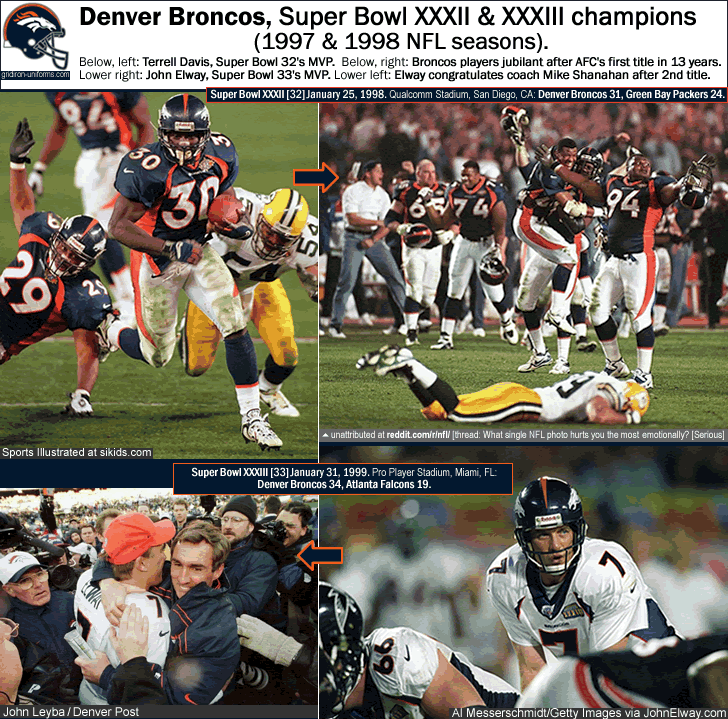
Photo and Image credits above -
Broncos 1997-98 helmet, illustration by Gridiron Uniforms Database. Photo of Terrell Davis by Sports Illustrated at sikids.com/photo_gallery. Broncos players jubilant after Super Bowl 32 victory, photo unattributed at this thread at reddit.con/r/football: 200 Days/200 Topics: Day 57: What single NFL photo hurts you the most emotionally? [Serious].
John Elway photo by Al Messerschmidt/Getty via JohnElway.com. Mike Shanahan and John Elway following Super Bowl 33 win, photo by John Leyba/Denver Post at extras.mnginteractive.com.
…
-
Colors and helmet logos of the Broncos…
Though the Denver Bears Triple-A ball club was wearing navy-and-red by the late 1960s, at one point in the history of the Denver Bears, the team (owned by Bob Howsam, who was of course the Denver Broncos first owner) was wearing brown (with red/orange) as its primary color {see this} [circa late 1940s/early 1950s]; at another point they were wearing gold-and-brown {see this Don Larsen throwback jersey at e.bay}. This photo shows an old Denver Bears pennant and a sign from Bears Stadium circa early-or-mid-1950s – both have brown in them. So what I am saying is that Bob Howsam had a history of using brown (and gold) in his team’s colors. This all might be a coincidence. The fact is that Howsam had his new Broncos organization on a rock-bottom low budget circa 1959-60, and the Broncos first GM Dean Griffing, a legendary tightwad perfectly happy to keep to the strict low budget, bought second-hand (probably third-hand) uniforms from a defunct college tournament in Tucson, AZ (the Copper Bowl). The uniforms featured a brown helmet (the player’s number on each side in white), a darkish-yellow jersey with brown numbers, shiny brown pants, and yellow-and-brown vertically-striped socks. The gear would have looked ridiculous anyway, but those socks made the whole team look comical – like a bunch of court jesters. The other thing was that the Broncos in 1960 only had to buy one set of uniforms, because the yellow jerseys could function as home darks or away whites and would not clash with any of the other AFL teams’ dark or white jerseys. Then Howsam sold the team to Gerald Phipps in 1961. Then in the summer of 1962 new coach Jack Faulkner had the team burn the vertically-striped socks in a bonfire ceremony following a training session at Bears Stadium…there were 8,377 Broncos fans in attendance for the immolation of the socks (a couple were saved for HoF posterity).
{For more on the brown-and-yellow Broncos uniforms of 1960-61, see this excellent article from EndZoneSportsCharity’s Denver Broncos Uniform History 1st GENERATION: 1960 – 1961.}
1962-64 – Pale Orange with White and Blue trim (with goofy-bronco logo)…
The Broncos switched to orange and blue first in 1962 (their third season), but there was very little blue (royal blue) in their gear in the ’62 to ’64 era. The pale orange helmets featured a cartoon-like bucking bronco (with giant lantern jaw making the horse look developmentally disabled). At first the goofy bronco logo was in royal blue (some games in ’62), but that was switched to a more-visible white later on in ’62 through ’64. From the Gridiron Uniform Database, {here are the Denver Broncos 1963-64 uniforms}.
1965-73 – Red-Orange with Royal Blue (goofy-bronco logo to blank blue helmet [1967], to red/orange-D-with-white-rampant-bronco logo on blue helmet)…
Then the Broncos switched their primary color to a sort of pastel red-orange – a color that is pretty unique in major-leagues sports history. That red-orange was paired with a grayish royal blue (Prussian Blue) {Broncos 1966 uniforms}. They finally got rid of the undignified goofy-bronco logo, and the Broncos organization must have figured a blank helmet was better than that (in 1967). In 1968, the once-iconic red/orange-D-with-white-rampant-bronco logo had its debut (see it here (photo from hugginsandscott.com)}. That D-with-the-white-bronco logo lasted from 1968 all the way to 1996. They should bring it back. Here is an excerpt from the Denver Broncos page at en.wikipedia.org,…”The logo was designed by Edwin Guy Taylor of Denver. A contest was held through Public Service of Denver to come up with a new logo for the team. Mr. Taylor’s submission was selected late in 1967 and adopted [in 1968].”…{excerpt from en.wikipedia.org/wiki/Denver_Broncos/Logos_and_uniforms}.
1974-96 - Orange and royal blue (with iconic orange-D-with-white-rampant-bronco logo on blue helmet)…
In 1974, the red-orange switched to a standard orange (well, maybe an orange that had a touch of burnt orange in it). The next link shows the Broncos uniforms the only year they had the orange (and not red-orange) D in their helmet and a grey facemask {Broncos 1974: a classic look; please bring it back, Denver}. {Here} is what the Broncos wore in their first Super Bowl appearance in 1978.
1997-2014: Navy-Blue and Orange (with stylized-bronco-head logo [aka Cyber Horse], and tapered-orange-center-stripe on navy blue helmet)…
Navy blue replaced orange (or red-orange) as the primary color. The cyber-horse logo, designed by Nike, is an elongated-white-bronco-head-with-streaming-orange-mane. It looks pretty juvenile, the sort of thing an 8-year-old would think is cool. The uniforms were initially savaged in the Denver press (lots of fans did not like it as well…at first). However, it cannot be denied that the first season that the Denver Broncos wore their totally revised uniforms of very dark blue and orange with elongated-bronco-head helmet-logo {Broncos 1997}, they went all the way and finally won their first Super Bowl…then they repeated the next season. I think that success right off the bat with this uniform design is why the team still wears this style uniform and logo 18 years later, unlike teams such as the Giants and the Jets and the 49ers and the Bills (and Chargers), who have all gone back to updated versions of older and better uniforms and logos in the last few years.
…
-
Kansas City Chiefs – logos and helmet history (1960-2014), click on image below…
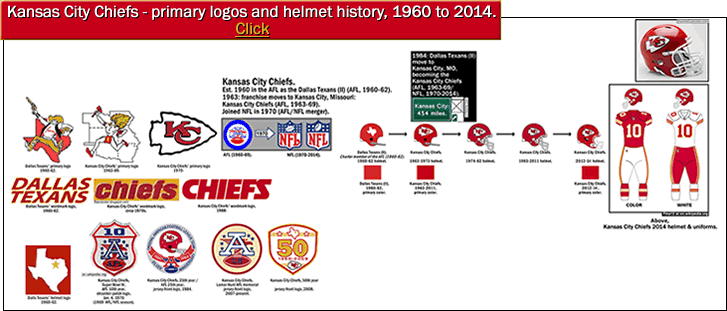
Kansas City Chiefs – logos and helmet history (1960-2014)
Texans/Chiefs helmet illustrations above from gridiron-uniforms.com/chiefs. Chiefs uniforms.png by fma12, en.wikipedia.org/wiki/File:Chiefs_uniforms.png. Photo of Chiefs 2012-13 Riddell helmet from thumbs3.picclick.com/d/w225/pict/251241604074_/KANSAS-CITY-CHIEFS-Riddell-Revolution-NFL-Football-Helmet.jpg. Dallas Texans’ 1960-62 wordmark logo from sportsecyclopedia.com/nfl/kcdal/daltexans. Photo of Chiefs’ circa 1970s wordmark logo from fleersticker.blogspot.com.
Origin of Chiefs nickname…
Upon moving his AFL franchise the Dallas Texans to Kansas City, Missouri in 1963, oil-fortune-heir Lamar Hunt was faced with the quandary of having to re-name his franchise. But actually, as hard as it is to believe, Hunt (at first) wanted to keep the nickname and call the team the Kansas City Texans. It took his right-hand-man, Jack Steadman (who was the Texans/Chiefs GM and vice president of operations), to convince Hunt otherwise. The mayor of Kansas City then, H. Roe Bartle, who was very instrumental in the city being able to lure the AFL franchise away from Dallas, was nicknamed “the Chief” (from his days as a Scout Executive of the St. Joseph and Kansas City Boy Scout Councils 35 years previously when he formed a Native Tribes honor society within the Boy Scouts called The Tribe of Mic-O-Say).
The Chiefs became the winning entry (but not the most popular entry by far) into the local name-the-new-team contest that Hunt had organized. The most popular of the 4,866 entries (with 1,020 different names being suggested) were for the nicknames the “Mules” and the “Royals.” “Chiefs”, suggested by 42 entries, was third-most-selected in the naming contest; nevertheless Hunt selected Chiefs as the football team’s new nickname. At other sources (like here) it is said Hunt re-named the team the Chiefs in honor of the large number of Native Americans who (past and present) had called the region of western Missouri and the Great Plains their home. At that is technically true. And that notion is re-enforced by the first primary logo of the new Chiefs franchise {see it by clicking on the on the image above or here}.
But the Chiefs are also named after the nickname of that former Kansas City mayor, H. Roe Bartle who helped get the team to KC and who made good on his promise to Lamar Hunt that Kansas City would have a vast season-ticket paying fan-base there even before the team’s arrival. And this was swiftly accomplished, as in a short span of time (8 weeks) in early 1963, over 20,000 season season tickets were sold to pro-football starved fans in and around Kansas City – before the franchise had even moved out of Dallas, and before the folks who forked over cash for the season tickets even knew exactly which pro team the city was getting. As it said in the timeline/1963 section of the official Kansas City Chiefs website, “the team was officially christened the Chiefs on May 26th, in part to honor the efforts of Bartle.” {excerpt from http://www.kcchiefs.com/history/60s/ [dead link/ now available via Wayback Machine at http://web.archive.org/web/20080609053609/http://www.kcchiefs.com/history/60s/ }.
For more on this, see the following article at SBnation, How the Kansas City Chiefs Got Their Name (article by oldchiefsfan from May 18 2009). In the comments section there, 2 commenters who were proud childhood members of the Boy Scouts' Tribe of Mic-O-Say weigh in: jbj8609 says ..."My father and I are both members of MOS (in St. Joseph, MO, not the KC one), and I can confirm this to be 100% accurate. My dad has been “Tribal Historian” here for several years now and used to tell me this story many times. Always thought it was very cool"; bankmeister says..."I’m also a Mic-O-Say member with five consecutive years at Bartle, plus my mom has lived off of Roe Avenue for 25 years. H. Roe and the Chiefs mean a lot to me." {end of excerpts.} The Kansas City Chiefs is a great name that honors Native Americans. Unlike the racist name of another NFL team.
-
Stadiums the Dallas Texans (II)/Kansas City Chiefs franchise have played in...
Cotton Bowl in Dallas, Texas (home of the Dallas Texans (II) from 1960-62)...
The Cotton Bowl began as Fair Park, a stadium built on the site of the Texas State Fair grounds, in 1930. Cut-and-fill construction was employed to build up berms for the stands, and this lowered the playing surface twenty-four feet below the original ground level. The stadium initially held 45,000 spectators; in 1936, the name was officially changed to the Cotton Bowl. The following year, 1937, the Cotton Bowl Classic college football Bowl game began being played there. But it wasn't a popularly-attended Bowl game until a partnership was created with the Southwest Conference starting in 1941 (and the Texas A&M versus Fordham game in '41 was the first Cotton Bowl Classic that was played to a sell-out crowd). By 1950 and through the 1960s, the Cotton Bowl could hold 75,000 (it has a 90,000-capacity now). The primary tenant, in its early days through to the mid-1970s, was the SMU Mustangs college football team; the failed NFL franchise the Dallas Texans (I) of 1952 played 4 of their scheduled 6 games there to sparse crowds, before the NFL front office took over the team and folded it at the end of the 1952 NFL season. In 1960, it would be the home of 3 football teams: the SMU Mustangs, the expansion NFL team the Dallas Cowboys, and the Dallas Texans (II), a charter member of the new rival-league, the AFL.
AFL founder Lamar Hunt, though Arkansas-born, was raised in Dallas, Texas (where his father's oil business was centered). His efforts to get an NFL team for Dallas circa 1958-59 had been unsuccessful. When he got the AFL off the ground and running in 1959-to-early-1960, there was never any doubt that he would have one of the 8 franchises in the new league and that it would be located in Dallas. This despite the fact that in the interim - in early 1960 - the NFL had awarded a Dallas franchise to someone else. So Hunt's Dallas Texans were instantly consigned to being the second-team-in-Dallas, simply by virtue of the fact that the NFL was more established. The red-and-yellow/gold Dallas Texans struggled to get media attention in their 3 seasons in Dallas, but in fact, in the team's first year in Dallas (1960), the AFL's Texans drew best in the debut-season of the AFL and outdrew the NFL's Cowboys (24,500 per game for the AFL Texans versus 21,417 per game for the Cowboys). Of course the first-year Cowboys were horrible (they went 0-11-1), while Hunt's Texans were competitive and fun to watch with a prolific-scoring offense (they went 8-6). But the next season, 1961, Texans' attendance plummeted almost 7K per game to 17,571, while the slightly-improved Cowboys (at 4-9-1) saw their attendance shoot up 33% to 24,521 per game. The writing was on the wall for Hunt. As football-crazy and as dynamic and growing as the city of Dallas was in the early 1960s, it still was not big enough to support two pro football teams. In the next season, 1962, even as an 11-3 team en route to the 1962 AFL title (see illustration below), the Texans were still unable to draw as well as they did their first year - they averaged 22,201 (the 5-8-1 Cowboys averaged only slightly less, at 21,778 in '63).
Hunt knew that once the Dallas Cowboys (inevitably) got competitive, they would totally overshadow the Dallas Texans and start claiming a much greater share of the ticket-paying public in the Dallas/Ft. Worth area. So Hunt threw in the towel and began looking for a new home for his team. New Orleans, Atlanta and Miami and Seattle were also considered, but thanks to that huge season-ticket-drive in KC, Hunt moved his team 450 miles north to Kansas City.
-
The Dallas Texans/Kansas City Chiefs: 3 AFL titles & 1 Super Bowl title in a 10-year-span...

Photo and Image credits above -
1960-62 Dallas Texans helmet, illustration from gridiron-uniforms.com/chiefs. Albert Haynes, photo unattributed at sportsnola.com. Photo of 1962 Dallas Texans AFL Champions team photo, unattributed at media-cache-ak0.pinimg.com. Hank Stram with AFL championship trophy, photo unattributed at media-cache-ak0.pinimg.com. Abner Haynes in 1962 AFL title game, photo unattributed at ntmeangreenfootball.com. USA blank map by Zntrip at Blank map of the United States. Aerial photo of Kansas City Chiefs playing at Municipal Stadium, photo by Kansas City Chiefs at kcchiefs.com/municipal-stadium-tribute. Hank Stram being carried off the field by Chiefs players after their 1966 AFL Championship Game win over Buffalo, photo unattributed at mmbolding.com/AFL1966. AFL 10 years patch worn by Chiefs in Super Bowl IV, photo unattributed/ uploaded by remembertheafl.com at Super Bowl IV (en.wikipedia.org). Len Dawson taking the snap in Super Bowl IV vs. Vikings, photo unattributed at arrowheadaddict.com/2013/06/16/chiefs-history-and-an-anniversary. Buck Buchanan and Curley Culp tackling Dave Osborn in Super Bowl IV, photo from USA Today via spokeo.com.
Municipal Stadium (Kansas City), home of the Chiefs from 1963-71...
Opened in 1923 and originally called Muehlebach Field, the venue was built as a ballpark for the Kansas City Blues (V) (1902-54) of the American Association. The Kansas City Monarchs Negro leagues team also played there (from 1923-34; 1937-54). For that reason the ballpark was situated at the edge of Kansas City's inner-city neighborhood. Capacity was originally 17,000, with the main feature of the ballpark being a single, roofed stand that ran the whole of the first-base foul-line to the right-field-foul-pole, but on the other side the roof only stretched to third base (making the roof a rounded L-shape). In 1955, prior to the arrival of the Philadelphia Athletics MLB franchise, the city decided to almost completely demolish the stadium and rebuild from scratch. The city ran three shifts - the new stadium was built in 90 days, in time for the April 1955 MLB opening of the Kansas City Athletics (1955-67). The not-quite-V-shaped-roof remained, now in a double-deck form, and capacity for baseball was then 30,000. It was re-named Municipal Stadium.
When Lamar Hunt decided to move his Dallas Texans to Kansas City in early 1963, the stadium was renovated again, but in more of a jury-rigged way - temporary stands were erected in left field to expand the stadium's capacity each fall, but had to be torn down before the start of the baseball season the following year.
Kansas City mayor H. Roe Bartle had helped get the team to KC, and had made good on his promise to Lamar Hunt that Kansas City would have a vast season-ticket paying fan-base there even before the team's arrival. Some sources say that Bartle promised to triple the crowds the team had drawn in Dallas (ie, 21.4 K times 3 equals 64 K) - but even if he did promise that, it would have been impossible because Municipal Stadium in Kansas City only held around 30,000 then, and even after expansion for football, it never had more than a 49,000-capacity {see this, stadiumsofprofootball.com/past/KCMunicipal}. The 1963 Kansas City Chiefs actually drew about 650 per game worse than they did the year before as the 1962 Dallas Texans (at 21,510 per game in 1963 versus 22,201 in '62) (note: 10-year AFL attendance figures for the Dallas Texans (II)/Kansas City Chiefs can be seen in the illustration above, and the source for those figures was at THE AMERICAN FOOTBALL LEAGUE - ATTENDANCE, 1960-69 By Bob Carroll at profootballresearchers.org.)
The Kansas City Chiefs upon arrival in KC in 1963 were reigning champions of the AFL, but the Chiefs then suffered a downturn in form and went 5-7-2 in '63; 7-7 in '64; and 7-5-2 in '65. Cumulative gate figures for those first 3 years in KC were 20,376 per game. So the fact that the Chiefs turned mediocre right when they arrived in KC certainly hurt attendances, and the crowds the Chiefs drew only got respectable after the Chiefs got good again - in 1966, when they tore up the AFL, going 11-2-1, winning the AFL Championship game (over the Bills, 31–7), and appearing in the first AFL-NFL Championship Game [aka Super Bowl I] (losing to the Packers, 35-10). In that great season of 1966, the Chiefs drew 37,010 (an increase of around 15.5 K over their ’65 attendance). Attendance-wise, the Chiefs have never looked back: they drew 45 K in ’67 (going 9-5); 48 K in ’68 (going 12-2); and 49 K in ’69 when they went all the way with an 11-3 record, beating the Raiders 13-6 in the last AFL Championship game and then winning Super Bowl IV [4] by upsetting the heavily-favored Minnesota Vikings by a score of 23-7 in the last game ever played by the AFL (see illustration above).
Following the Jets’ upset of the NFL’s Colts in Super Bowl III, the Chiefs’ similar upset of the Vikings in Super Bowl IV made it plain for all to see that the AFL was the deserved equal of the NFL. Actually, the AFL beat the NFL soundly in the last two match-ups between the two leagues, so it basically looked like the once-derided upstarts had actually surpassed their hide-bound rivals…in ten years flat. The Chiefs played their first two seasons in the NFL at Municipal Stadium (1970-71), then moved into their purpose-built Arrowhead Stadium in September 1972.
Arrowhead Stadium – home of the Chiefs since 1972…
To see how the Chiefs’ Arrowhead Stadium came to be, we need to backtrack about 5 years, back to early 1967. Although having just lost in a convincing fashion to the Green Bay Packers in what we now call Super Bowl I, the Chiefs were nevertheless a solid and growing franchise circa early 1967. They had won 2 AFL titles in six seasons, and were now drawing in the 37,000-per-game range. Half a year later in the autumn of 1967, Chiefs were drawing around 45,000 per game [this after their first 3 years in KC when they had lackluster attendance, failing to draw above 22 K per game (1963-65/see attendance figures in illustration above]). All signs pointed to further attendance increases for the Chiefs. They were playing to nearly-full capacity at this point, and the aging Municipal Stadium, located in its inner-city neighborhood, was becoming inadequate for the them and their fans. Locations for a new stadium for the Chiefs and the Athletics were scouted by the city of Kansas City starting in early 1967, but a suitable location was never found, and so just across the county-line in Jackson County, Missouri, at the far eastern edge of Greater Kansas City, a location adjacent to an interstate highway interchange was designated. Hunt had operations-chief Jack Steadman work on the stadium design. Denver architect Charles Deaton was brought in by Steadman and it was Deaton who suggested that the two teams, playing as they were in sports that had such radically different configurations, would be better served if each team had its own stadium. Its own stadium that was configured to its own sport’s configuration (a rectangular-shaped stadium for the football team, and a half-circle-atop-a-triangle-shaped stadium for the baseball team). The 2 venues could share a parking lot complex which would reduce costs by sharing parking and highway expenses. This was the exact opposite of conventional wisdom of the time. The late 1960s was the heyday of the now-derided multi-purpose stadium era (an era that lasted up to the late 1980s), or as I like to call it, the Robert Moses Disease. Circa 1960 to 1988 or so, the urban planners running metropolitan areas ignored the basic fact of the fundamental incompatibility of putting the two very different sports into the same stadium, and forced ugly, astro-turf laden cookie-cutter, multi-purpose concrete stadiums on the public. The whole idea was “we can put our baseball team and our NFL football team in the same stadium, and who cares if the dimensions of the two sports fields are totally incompatible”.
I am not exaggerating in saying that Mr. Deaton’s visionary idea (which is the norm today), has helped to elevate the fan experience in both the NFL and in Major League Baseball. Once there were over a dozen multi-use stadiums in MLB and in the NFL, and they all sucked, because they were designed to host two very incompatible configurations. They were giant soul-less concrete doughnuts that gave the fan – for either sport – vast yawning empty spaces where there should have been seats, and sight-lines looking upon totalitarian-architecture backdrops of brutal concrete. [By 2010, following the Minnesota Twins opening of their Target Field, there was only one multi-purpose stadium still in use in both the NFL and MLB - Oakland's stadium, and its days are numbered.]
Here is an excerpt from the Kauffman Stadium page at en.wikipedia.org,…”In 1967, voters in Jackson County, Missouri approved the bonds for Truman Sports Complex, which featured a football stadium for the Kansas City Chiefs and a baseball stadium for the Kansas City Athletics, whose owner, Charles O. Finley, had just signed a new lease to remain in Kansas City. This was a very unusual proposal; conventional wisdom at the time held that separate football and baseball stadiums were not commercially viable.”…{end of excerpt from en.wikipedia.org/wiki/Kauffman_Stadium#History. The two stadium sports complex, what became known as the Truman Sports Complex, would prove to be twenty years ahead of its time.
But then a wrench was thrown into the works when, in October, 1967, MLB gave A’s owner Charlie Finley permission to move his Kansas City Athletics MLB franchise west to Oakland, CA (in 1968). The folks in and around Kansas City were so enraged about losing their pro ball club they pressured their elected officials to act. Partly thanks to the threat to introduce legislation in the US Senate to remove MLB’s antitrust exemption (put forth by Missouri Senator Stuart Symington), MLB hastily began plans for another round of expansion at the winter meetings in 1967, so both Kansas City and Seattle got MLB AL expansion franchises; and both San Diego and Montreal, Quebec, Canada got MLB NL expansion franchises, all 4 teams set to begin play in 1969.
At about the same time, the Jackson County Sports Complex Authority was created, and construction began in 1968 for the two-stadium Truman Sports Complex (named in honor of western-Missouri-born-and-bred President Harry S. Truman). The second-year Kansas City Royals began playing at the new 37,000-capacity Royals Stadium in April, 1972 (the venue is now called Kauffman Stadium in honor of the Royals’ first owner, Ewing Kauffman). The Chiefs began playing at the new 78,000-capacity Arrowhead Stadium in September, 1972 (after several renovations, Arrowhead, since 2010, now has a capacity of 76,416). The original two-stadium concept, initially designed by Denver architect Charles Deaton and Jack Steadman, was implemented in its final design by the Kansas City architectural firm of Kivett & Myers. The template for what was to be called Arrowhead Stadium is said to have influenced the design of several NFL stadiums. Both stadiums were very well designed and have had very good upkeep – both stadiums are still in excellent shape. And both teams have no plans of moving elsewhere (either out of town or into another costly new stadium), as opposed to the case with EIGHT now-demolished multi-purpose stadiums that were built in the USA in the same era or later. Specifically, in Minneapolis (Metrodome demolished in 2014), in Queens, New York (Shea Stadium demolished in 2007), in St. Louis (Busch Memorial Stadium demolished in 2005), in Philadelphia (Veterans Stadium demolished in 2004), in Cincinnati (Riverfront Stadium demolished in 2002), in Pittsburgh (Three Rivers Stadium demolished in 2001), in Seattle (Kingdome demolished in 2000) and in Atlanta (Atlanta–Fulton County Stadium demolished in 1997) [note: soon Candlestick Park in San Francisco can be added to this list of demolished multi-purpose stadiums, as with the vacating of the 49ers after the 2013 season, the dreary Candlestick Park has no primary tenant].
Below: the Truman Sports Complex -the first major league sports stadium complex in the USA which rejected the misguided multi-purpose stadium model.

Photo and Image credits above -
Chiefs 2012-14 Pro Revolution helmet, illustration by gridiron-uniforms.com/teams/2012_KansasCity.
Kauffman Stadium and Arrowhead Stadium as seen from the nearby interstate highway, photo unattributed/ uploaded by KingmanIII at skyscrapercity.com/ [thread: Closest stadiums]. Arrowhead Stadium aerial photo, by Ichabod at en.wikipedia.org/ [Arrowhead Stadium page].
…
Below: Lamar Hunt and Bud Adams (photo circa 1960)…
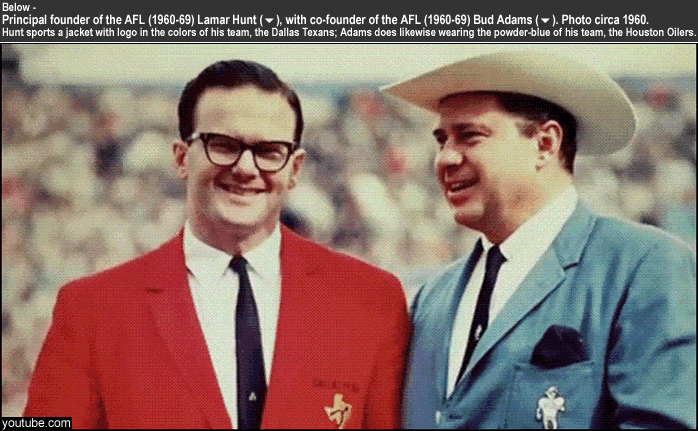
Image credit above -youtube.com/watch?v=W1sL0gf_LXI (youtube.com video uploaded by Scott Sillcox).
-
Colors and helmet logos of the Texans/Chiefs
The following link is to a 1 minute and 53 seconds-long video (produced by the NFL and Tide detergent), Kansas City Chiefs uniform and uniform color history (video uploaded by Scott Sillcox at youtube.com)}.
1960-62 – Red and Yellow/Gold (map-of-Texas-with-gold-star-for-Dallas helmet-logo, on a plain red helmet)…
Lamar Hunt actually wanted the Dallas Texans to wear orange-and-sky-blue, but Bud Adams’ Houston Oilers had already chosen powder blue as their primary color, so Hunt had to come up with a different color scheme (thank goodness for that). Hunt chose a simple yet striking red-with-yellow/gold…the franchise has never worn any other colors. The Texans/Chiefs have also only worn a red helmet with no stripe detail (a wise decision because the inherent high-potency of the color red ends up being diluted by the often-at-cross-purposes imposition of a center stripe…especially when that red is paired with a shape in the logo that is slightly more complex than a block letter or a circle). First (1960-62), the red helmet had a logo that was the-state-of-Texas-with-gold-star-for-Dallas {see that nice design here in a game-worn helmet from the 1960-62 era}.
1963-2014 – Red and Yellow/Gold (arrowhead-with-interlocking-K-C helmet-logo, on a plain red helmet)…
When Hunt moved the team to Kansas City, the story goes he himself drew out the new logo in his kitchen on a dinner napkin…sketching out a design influenced by the San Francisco 49ers’ interlocking-S-F, but with an arrowhead framing the letters K-C instead of the football-shaped-oval on the Niners’ helmet. That design debuted in 1963 and, aside from a slight reshaping of the logo in 1974 (the arrowhead was made a bit smaller and the K-C a bit larger), it has remained the Chiefs helmet design for over 50 years. And rightly so. The Chiefs’ bold yet dignified helmet looks as sharp today as it did a half century ago; the same can be said for their uniforms {2013 Chiefs uniforms}.
…
-
Oakland Raiders – logos and helmet history (1960-2014), click on image below…

Oakland Raiders – logos and helmet history (1960-2014)
Raiders helmet illustrations above from, gridiron-uniforms.com/raiders. Photo of Raiders 2012-13 Riddell helmet from, lnt.com/nfl-authentic-revolution-pro-line-full-size-football-helmets/oakland-raiders-authentic-pro-line-revolution-riddell-helmet. Raiders 2014 uniforms, illustration by JohnnySeoul at en.wikipedia.org.
Origin of Raiders nickname…
The franchise that became the Oakland Raiders was the last of the 8 charter members of the AFL in 1960. A year before when the league was being formed, that 8th franchise was originally intended to be placed in Minneapolis/St. Paul, Minnesota. But when the NFL convinced the AFL-ownership-group in Minneapolis/St. Paul to take an NFL franchise instead, the Minnesota Vikings were born (set to start in the NFL in 1961), forcing the nascent AFL to scramble to find a location for the 8th team. The 6 other AFL owners were then coerced by Chargers owner Barron Hilton to put another team in California, following Hilton’s threat to pull out of the league if there was not another AFL team placed in the Golden State, so the 8th AFL franchise was placed in Oakland, CA. This despite the fact that the well-supported San Francisco 49ers were just a few miles across the San Francisco Bay from Oakland, and it would thus be an uphill battle for an Oakland-based AFL team to draw well. And this despite the fact that there was no stadium on the east side of San Francisco Bay, except for the California Golden Bears’ stadium in Berkeley, CA.
Here is how the formation of the AFL franchise in Oakland went {2 excerpts from Oakland Raiders/History at en.wikipedia.org}…”Upon receiving the franchise, a meeting of local civic leaders and businessmen was called, chaired by former United States Senator William F. Knowland, editor of the Oakland Tribune; Edgar Kaiser of Kaiser Steel; developer Robert T. Nahas; and Oakland City Councilman Robert Osborne. Also attending the meeting [was] Oakland Mayor Clifford E. Rishell [and 7 other city councilmen]…/…A limited partnership was formed to own the team headed by managing general partner Y. Charles (Chet) Soda, a local real estate developer, and included general partners Ed McGah, Oakland City Councilman Robert Osborne, F. Wayne Valley, restaurateur Harvey Binns, 1928 Olympic gold medalist Donald Blessing, and contractor Charles Harney, the builder of San Francisco’s Candlestick Park, built on a bleak parcel of land he owned…”…{end of excerpts from en.wikipedia.org/Oakland Raiders/early years)}.
An example of how disorganized the early days of the Oakland/8th-AFL-franchise was, can be seen in the fact that for 9 days, the team was officially known as the Oakland Señors. This came about when the team’s first GM and one of the 4 co-owners, Chet Soda, organized a name-the-new-team contest held in the Oakland Tribune. Then on April 5, 1960 it was announced in the Tribune that the winning entry was for the nickname the Señors, a reference to the Spanish settlers of northern California. Here is what an article at Raider Nation Times.com has to say about that…{excerpt}…”Although somewhat appropriate due to Oakland’s large Hispanic community, the team became a local laughingstock as everyone knew Soda was renowned for calling his acquaintances Señor and extrapolated that to mean the contest was clearly fixed.”…{end of excerpt at Oakland Raiders Logo and Colors Have a Rich and Interesting History (raidernationtimes.com/article by Justin Smith – Jul 19, 2012). A classic line was made by future Raiders GM and then-Tribune-sportswriter Scotty Stirling, who said, “That’s no good, we don’t have the accent mark for the n in our headline type.” {quote from http://mentalfloss.com/article/25650/whats-nickname-origins-all-32-nfl-team-names by Scott Allen}. So, nine days later, the third-most-selected name was chosen, and the Oakland Raiders were born on April 14, 1960.
-
Stadiums the Oakland Raiders/Los Angeles Raiders have played in…
Kezar Stadium in San Francisco (4 games in 1960); Candelstick Park (last 3 games in 1960, all 7 games in 1961)…
The University of California at Berkeley refused to allow the new Raiders to play at their Memorial Stadium, so the Raiders were forced to play across the San Francisco Bay in San Francisco at Kezar Stadium (home of the 49ers), for 1960. Despite being forced to pick over the remainders of available talent for their squad (all 7 other AFL squads had generally been formed before the Oakland AFL franchise got going), Oakland did not do too bad at all in their first season. With a lopsided total of 28 rookies in their squad and with only 14 veterans, the black-helmeted Raiders finished a respectable 6-8 (2 of those rookies were future Pro Football Hall of Famer Center Jim Otto, and a future Raiders head coach, the QB Tom Flores). But the Raiders in their debut season in 1960 drew an awful 9,612 per game (4 games at Kezar Stadium, then their final 3 home games at Candlestick Park). Then the bottom fell out in the Raiders’ next two seasons. After the Raiders had dismissed coach Eddie Erdelatz in late September 1961, his replacement, offensive line coach Marty Feldman fared no better, and in their second year at cold and windy Candlestick Park, the ’61 Raiders went 2-12 and drew an abysmal 7,655 per game.
Frank Youell Field, the temporary stadium the Raiders played in for 4 seasons (1962-65)…
A consortium led by Wayne Valley and including minority-owner Ron McGah purchased the Raiders in 1961, and the consortium threatened to move the franchise if Oakland city officials didn’t provide a venue in Oakland. This made the city construct Frank Youell Field, a temporary facility in downtown Oakland which held about 15,000 people initially (capacity increased to 22,000 the same year it opened in 1962), the use of which was shared with high schools.
From the Today In Pro Football History blog, …{excerpt}…”Stadium was constructed by the Oakland Recreation Commission as a temporary home for the Raiders until the Oakland-Alameda Coliseum was completed. Named for Francis J. Youell, a city council member and prominent local sports booster.”…{end of excerpt at Past Venue: Frank Youell Field, by Keith Yowell at fs64sports.blogspot.com)}.
So in 1962, the hapless Raiders finally played in Oakland, but they were still bad – Red Conkright replaced Feldman after 5 winless games in October ’62, and the Raiders finished rock bottom again, at 1-13. In their first season playing in Oakland they drew 10,985 at Frank Youell Field. The Raiders had no idea at the time, but they would have to play three more seasons at the temporary stadium while the building of the Oakland-Alameda County Stadium hit a series of delays. The reason why it took so long to get Oakland’s multi-purpose stadium built was that it was being built in conjunction with the basketball/hockey/events arena (the Oakland Coliseum, which is next-door to the stadium and shares a parking facility/ see photo in illustration below) – both venues being built by a city/county/non-profit partnership. Then the 54,000-capacity Oakland-Alameda stadium construction schedule (which started in the spring of 1962) was delayed for two years due to various legal issues and cost overruns. Then the original design of the arena (the Oakland Coliseum) had to be modified slightly in order to stay on budget, and that slowed the dual-stadium-construction-project even more. So the Raiders were stuck playing in the all-bleachers Frank Youell Field for 4 years. The makeshift “stadium” was located in an industrial area of downtown Oakland (as you can see in the photos in the illustration below). Frank Youell Field was torn down in 1969 so that nearby Laney College could use the site as a parking lot.
In January, 1963 Al Davis was hired…
In January, 1963 Al Davis was hired by Wayne Valley as head coach and GM of the Raiders. Davis, just 33, became the youngest ever pro football head coach. The Brooklyn-raised Davis had been assistant coach of the San Diego Chargers where he was backfield coach, and an adept scout, and a general fast-talk-artist not above blatant and fabricated self-promotion and outright lying to further his cause. As Valley later said, “Everywhere I went, people told me what a son of a bitch Al Davis was, so I figured he must be doing something right.” {quote from Al Davis page at en.wikipedia.org/Al Davis/Background and hiring}. Valley would regret this move 9 years later when Davis wrested control of the Raiders from him. “Davis’s theory is that people are motivated by fear,” said Bob Bestor, who resigned as Raiders’ business manager in the late 1960s to do publicity for the new Oakland Seals hockey team. “He thinks people perform better if they’re afraid.” {preceding quote from article by Leonard Shecter in Look magazine, The Most Hated Winner In Football: Al Davis In 1969 (thestacks.deadspin.com)}.
Davis intended to bring over an aggressive passing-oriented offense, the type he had seen become proficient at San Diego under visionary head coach Sid Gillman. For the 1963 season, Davis, despite being new to the organization, still had enough leverage this early on to actually convince the Raiders’ front office to change the team’s colors from black-and-yellow/gold with plain black helmets, to silver-and-black with silver helmets (with a distinctive shield logo), black jerseys and silver pants. From his experience coaching teams in the military (at Fort Belvoir, Virginia) and at a military school (the Citadel in South Carolina), Davis sought to motivate his players with relentless practice, drilling into them a pride for the team. Slogans became utilized. “Pride and Poise,” “Commitment to Excellence,” and “Just Win, Baby” are all registered trademarks of the Oakland Raiders. The turnaround for the Raiders was immediate – they went went 10-4 and Al Davis was voted AFL Coach of the Year. That 9-game improvement from the previous season (1-13 in ’62/10-4 in ’63) is a pro football record from the 14-game-era. The Raiders went from worst offense in the AFL in ’62 to second-best in ’63 (behind the Chargers, who won the 1963 AFL title). Though the Raiders slipped to 5–7–2 in 1964, they rebounded to 8–5–1 in 1965.
Then Davis left the Raiders organization for what turned out to be four months, when he was selected by the owners to replace Joe Foss as Commissioner of the AFL. This came about because the AFL owners wanted an aggressive commissioner to face off against the NFL. By the close of the 1965 season, the American Football League, after 6 years, had basically become a significant rival to the NFL. The AFL had increased its attendance remarkably. The AFL went from averaging 15 K per game in 1960, to averaging 31 K per game in 1965. The AFL’s television contract with NBC, and the several major stadiums being built for AFL teams were indications that in late 1965/early 1966, the AFL was starting to look like it was a success. The AFL was reaching the point where they were becoming able to compete on equal terms for players with the NFL. But aside from Sonny Werblin (NY Jets co-owner), most AFL owners wanted to be a part of the older, better-established NFL. They and most NFL owners feared continued escalation of player salaries.
The AFL was gaining on the NFL, and merger was becoming a possibility. AFL founder and Chiefs owner Lamar Hunt wanted the brash and dynamic Davis in the commissioner’s seat fighting the NFL, and Davis as a 37-year-old got the job in April 1966. Davis wanted AFL teams to go after NFL stars and basically scare the NFL franchises into thinking that they would be, for lack of a better word, raided by the AFL (there is Davis using fear as a motivator again). Lots of rumors about which NFL stars might jump to the AFL abounded in the early summer of 1966 – big-name players like Mike Ditka of Chicago and Alex Karras of Detroit and Paul Hornung of Green Bay. This happened because two player-raids were attempted. The Raiders went after LA Rams QB Roman Gabriel, and the Houston Oilers went after SF 49ers QB John Brodie – and both were signed in the early summer of 1966 by those AFL teams [but the two ended up staying with LA and SF respectively, because by then the AFL-NFL meger had been agreed to, and those contracts were nullified]. Glenn Dickey, a biographer of Al Davis {Just Win, Baby: Al Davis and His Raiders at amazon, here}, pointed out that Davis felt he was deceived by the owners, “He thought he had been hired to win the war with the NFL. In fact, the owners only wanted to force a peace. They were quietly negotiating a merger while Davis was fighting a war.”…{excerpt from Al Davis/AFL commissioner (en.wikipedia.org)}.
The AFL-NFL merger agreement was announced on June 8, 1966, with the creation of an annual title game to be first played in January 1967 (the AFL/NFL Championship Game, now called the Super Bowl), and with the AFL and the NFL to continue on as separate leagues for 4 more seasons (1966, ’67, ’68, ’69), and with a fully-integrated schedule and two balanced conferences implemented for the merger in 1970. Davis was not happy with the agreement, both because it required the Jets and Raiders to pay indemnities to the New York Giants and the San Francisco 49ers for establishing teams within their exclusive territories, and because it put him out of a job, because the merger made the office of the AFL commissioner redundant (Pete Rozelle would continue in his post as NFL commissioner under the merger agreement). Davis resigned as commissioner on July 25 (he was on the job for less than 4 months). Davis went back to the Raiders organization, now a 10% owner and now head of football operations (Davis would snatch total control of the Raiders franchise in 1972 when Valley was at the Olympics in Munich, Germany and Davis had his attorneys completely revise the ownership agreement, which third-ownership-partner McGah signed…and the courts upheld this).
Below: the first years of the Oakland Raiders (1960-67)…

Photo and Image credits above -
Illustrations of Raiders 1960-63 uniforms by gridiron-uniforms.com/raiders. Frank Youell Field sign, photo unattributed at football.ballparks.com/NFL/OaklandRaiders. Aerial black-and-white photo, unattributed at football.ballparks.com. Frank Youell Field, black-and-white photo, unattributed at fs64sports.blogspot.com/2011/04/past-venue-frank-youell-field. 1963 photo of Al Davis on the sidelines talking to QB Cotton Davidson with back-up QBTom Flores in head-set with clipboard, photo by Ron Riesterer / Oakland Tribune at oaklandtribunearchives.tumblr.com. Aerial photo of Oakland–Alameda County Coliseum complex, unattributed at alamedainfo.com/san_leandro_bay_pg_3. Daryle Lamonica and Gene Upshaw, photo by USA Today via spokeo.com/Daryle+Lamonica. Photo of game event poster of Second AFL-NFL World Championship Game [aka Super Bowl II], from sportsposterwarehouse.com.
September 1966: Raiders move into the Oakland-Alameda County Stadium…
In 1966, Al Davis’ hand-picked successor as head coach was John Rauch. The Raiders were finally playing in the 55,000-capacity stadium they would play in for the next decade-and-a-half. The Raiders played to 95%-capacity in 1965, at 21 K per game in their last year at Frank Youell Field. The following year, 1966, finally at Oakland-Alameda County Stadium, they averaged 36 K. By 1969, the Raiders were playing to 97%-capacity, drawing 53 K per game there.
In 1966 the Raiders finished 8-5-1, with starting QB Tom Flores and featuring a receiver corps that included Hewritt Dixon and Fred Biletnikoff (both WRs), as well ex-Oilers great Billy Cannon (at TE/HB). Then in the off-season the Raiders acquired back-up Buffalo Bills QB Daryle Lamonica in a trade. Lamonica was a strong-armed QB, and he threw a league-best 30 TD passes in 1967, as the Raiders tore up the AFL, with a league-best offense that averaged 33.4 points per game, and a defense that was second-best (the Oilers had the best D in the AFL in ’67). The Raiders then won the 1967 AFL Championship game over Houston, blowing out the Oilers 40-7. But just as the Kansas City Chiefs had been outclassed by the Green Bay Packers in the first Super Bowl the previous season, so too were the 1967 Raiders schooled by Lombardi’s Packers in Super Bowl II in January 1968, losing 33-14.
…
1976 season: Oakland Raiders win Super Bowl XI…

Photo and Image Credits above -
Ted Hendricks, photo by USA Today at spokeo.com. Fred Biletnikoff, photo unattributed at tddaily.com/nfl/greatest-sb-players-no-44-fred-biletnikoff. Ken Stabler handing off to Clarence Davis with Mark Van Eeghen blocking, ;& John Madden being carried off field by Raiders players incl. Ted Hendricks, photos unattributed at democraticunderground.com.
…
1980 season: Oakland Raiders win Super Bowl XV…
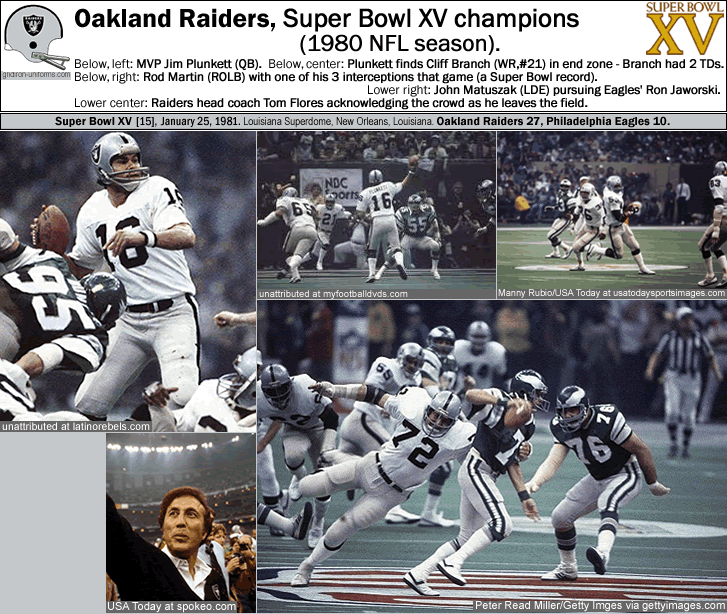
Photo and Image Credits above -
Jim Plunkett in pocket, photo unattributed at latinorebels.com/four-proud-latino-nfl-players-who-have-played-in-the-super-tazon. Plunkett about to pass to Cliff Branch for TD, photo unattributed at myfootballdvds.com. Rod Martin intercepting a pass, photo by Manny Rubio/USA Today via usatodaysportsimages.com. Tom Flores, photo by USA Today at spokeo.com. John Matuszack pursuing Ron Jaworski, photo by Peter Read Miller/Getty Imges via gettyimages.com.
…
Oakland Raiders move to Los Angles as Los Angeles Raiders; play in LA Memorial Coliseum for 13 seasons (1982-94)…
Al Davis wanted to leave Oakland because city officials refused to make improvements to Oakland-Alameda Coliseum. It primarily came down to their refusal to build luxury suites. In 1980 Davis signed an agreement to move his team from Oakland to Los Angeles. League owners voted 22-0 against the franchise-move (five owners abstaining). Davis tried to move the team, anyway. The NFL took him to court, Davis counter-sued, and Davis won an antitrust lawsuit against the NFL, clearing the way for the team’s relocation. “Sure, I expected the Oakland fans to get angry at me,” Davis said. “But I don’t remember any of them parading on the Oakland Coliseum, saying ‘Give him what he wants.’ In their mind, it’s their team. In my mind, it’s not.” {preceding quote from article at ESPN, Good guys wear black, by Mike Puma (espn.go.com/classic)}. Davis moved the Raiders to the Los Angeles Coliseum for the start of the 1982 season. The LA Coliseum had been vacant of a primary tenant since the end of the 1979 season, when the LA Rams moved a few miles southeast to Anaheim in Orange County (into the California Angels’ Anaheim Stadium).
1983 season: Oakland Raiders win Super Bowl XVIII…

Photo and Image credits above -
Raiders helmet, illustration by gridiron-uniforms.com/Raiders. Derrick Jensen blocking Redskins punt, photo unattributed at fs64sports.blogspot.com/1984-raiders-overwhelm-redskins. Jim Plunkett, photo by Getty Images via espndeportes.com/blogs. Marcus Allen on a long gain, photo unattributed at taylorblitztimes.com. Lester Hayes celebrating win, photo by Focus In Sports/Getty Images via gettyimages.com. Tom Flores being carried off the field, photo by Chris Hayt/Getty Images via espn.go.com/blog.
The Raiders played 13 seasons as the Los Angeles Raiders, then they returned to Oakland for the 1995 season. Here is an excerpt from the Oakland Raiders page at en.wikipedia.org..{excerpt}…”As early as 1986, Davis began to seek a new, more modern stadium away from the [Los Angeles] Coliseum and the dangerous neighborhood that surrounded it at the time…/…In addition to sharing the venue with the USC Trojans, the Coliseum was aging and still lacked the luxury suites and other amenities that Davis was promised when he moved the Raiders to Los Angeles. Finally, the Coliseum had 100,000 seats and was rarely able to fill all of them, and so most Raiders home games were blacked out on television. Numerous venues in California were considered…”…{end of excerpt from en.wikipedia.org/wiki/History_of_the_Oakland_Raiders#1982-88}.
In January 1989 Davis began negotiating with the city of Oakland to return the franchise there, and an agreement was reached in March 1991, but various delays kept the team from returning until 1995 to the Oakland-Alameda County Stadium (the stadium, still home of the A’s and the Raiders, is called O.co Coliseum now). In 1995, Davis finally got his coveted luxury suites, thanks to the Frankenstein-monster that the Oakland-Alameda County Stadium has now become, complete with a gigantic looming Death Star-like stand behind the center field wall (see below). The multi-tiered-stand now blocks the view that baseball fans once had of the Oakland Hills behind center field. Its derisive name is Mount Davis.
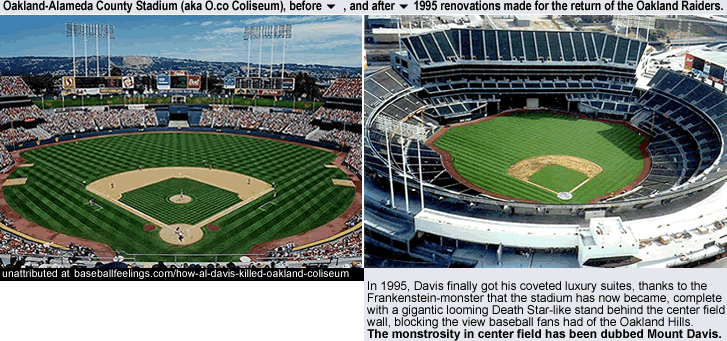
Photo credits above – both stadium-photos unattributed at baseballfeelings.com/2011/04/how-al-davis-killed-oakland-coliseum.
…
-
Colors and helmet-logos of the Raiders
The following link is to a 1 minute and 50 seconds-long video, Oakland Raiders uniform and uniform color history (video uploaded by Scott Sillcox at youtube.com)}.
1960-62 – Black and Yellow/Gold (plain black helmet)…
Like the Broncos early days, the first-year Oakland Raiders franchise was pretty cash-strapped, and, like the Broncos, the Raiders’ first color-scheme was the result of second-hand uniforms bought on the cheap. From the Al Davis page at en.wikipedia.org…”The Raiders, in their first season, had adopted the colors—and cast-off uniforms—of the University of the Pacific, black and gold.”…{excerpt from en.wikipedia.org/wiki/Al_Davis/Youngest_coach_in_the_AFL. It was actually black and yellow/gold. The helmets were plain black in 1960. In ’61 and ’62 a yellow-gold center-stripe was added to the black helmet. The helmets were also the old MacGregor style – a style with bulging ear-holes that had their heyday about a decade earlier, and they looked pretty dated circa 1960-62. Al Davis changed that when he came aboard in early 1963 as the Raiders head coach and GM (and designer of the Raiders’ new uniforms). Here is a photo from Al Davis’ first season with the Raiders, the photo taken in training camp, where you can see the old black Raiders’ helmet [worn by then-backup QB Tom Flores, on the left of the photo], and the new helmet of silver-and black-with-proto-shield-logo [1963-only helmet] worn by QB Cotton Davidson on the right of the photo {see it here}.
1963 to present – Black and Silver (with shield-logo [in proto-type-stage] on the silver helmet in 1963; with shield logo revised in 1964/ no changes in helmet-design since 1964)…
Al Davis was color-blind, and saw primarily only grays; Davis would go on to have a personal style which involved only the wearing of white, black or gray. The Raiders’ colors reflect this. Davis designed the Raiders uniforms right upon joining the organization in 1963. Their dark (home) uniforms had absolutely no white in the jersey (black with silver numbers) or pants (silver with a black stripe). The prototype-shield-logo was at first ill-conceived because the football helmet that the eye-patch-wearing man in the shield-logo is wearing is still the old plain-black helmet, not the team’s new silver helmet. That was corrected the next season in 1964 {link to those logos: Raiders’ primary logos, here}.}. So the Raiders’ helmet has not changed one bit since 1964. With the re-working of the shield-logo, the Raiders’ look was established. Only one slight variation in the Raiders’ uniforms has been [temporarily] changed since 1964…for a few years, when their white jerseys had silver-and-black numbers as opposed to black numbers (in 1963, in 1964, in 1970, and in 1997 [alternate]/ see this photo, from 1970, of C Jim Otto and QB Daryle Lamonica, in those smart-lookiing white-Raiders-jerseys-with-the-silver-and-black-numbers). In other words, the Raiders organization has not messed with their look at all. Which has proven to be a wise policy. The Raiders in their black jerseys (with silver numbers and no white at all) give them one of the most intimidating appearances in pro sports. And the Raiders in their white jerseys (with black numbers and no unnecessary trim at all) look understated and dignified.
…
-
San Diego Chargers – logos and helmet history (1960-2014), click on image below…

San Diego Chargers – logos and helmet history (1960-2014)
Chargers helmet illustrations above from, gridiron-uniforms.com/chargers. Chargers 2014 uniforms, illustration by JohnnySeoul at en.wikipedia.org. Chargers helmet, photo from wallstickers-decals.com/store.
Origin of Chargers nickname…
The Los Angeles Chargers, charter member of the AFL in 1960, were nicknamed the Chargers through a confluence of three things: 1) the winning entry in a name-the-new-team contest (the winner won an all-expenses-paid vacation to Mexico City); 2) the act of yelling “Charge” when a horse brigade attacks; 3) the colloquial term for buying with credit cards (charging it). The idea of a charge coming from a lightning bolt also entered into the name, and that can be seen by the lightning bolt’s prominent part of the Los Angeles Chargers’ first logos (official logo and helmet logo) – the lightning bolt has always been the Chargers’ logo.
Chargers founder/original owner Barron Hilton had created the then-prominent credit card Carte Blanche in 1954 (it was acquired by [the company now called] Citicorp in 1978, and is now part of their Platinum card). Carte Blanche credit card was created in conjunction with the Hilton Hotels chain (Barron Hilton is an heir to that fortune). Meanwhile, through the 1950s, Los Angeles-resident Hilton had been impressed by the famous USC Tojans marching band’s stirring ritual, at the LA Memorial Coliseum, of sounding the bugle and getting the Trojan fans to yell “Charge!”, right before kickoff. A “charger” is also the Medieval term for an armored war-horse that bore a knight into battle. Along with the aforementioned lightning-bolt, the first Chargers’ logo had a horse’s head within the shield {here}.
Now there are some (like some of the suits who run the NFL, or simply Chargers fans in denial) that don’t want it known or don’t want to admit that an NFL team was partially named after a credit card – and a rich-person’s-type of credit card at that. The Pro Football Hall of Fame’s entry on the subject does not mention the credit-card-angle {here}, but then, that article is a PR exercise that refuses to acknowledge, for example, that the New York Jets were named after the fact that they played next to Laguardia Airport. Hilton later denied the credit-card connection to the name {here/second paragraph there, which says “Hilton named his team the Chargers, but denies that he did it to create synergy with his new credit card business.”}. But the businessman who bought the San Diego Chargers from Hilton in 1966, Gene Klein, says Hilton told him that the Chargers were named after a credit card [or specifically, the active-verb that describes what one does with a credit card]. Klein says so in his autobiography, First Down and a Billion {at Amazon, here}. And in this 1-minute-&-41-seconds youtube video, a football historian connected with the PFHoF (Joe Horrigan) contradicts the PFHoF’s website’s stance on this when he does say that the Chargers’ nickname was partially the result of Hilton’s credit card company, {see this, San Diego Chargers uniform and uniform color history video uploaded by Scott Sillcox at youtube.com}.
Here is an article at the Mental_floss site about origins of NFL nicknames, What’s in a Nickname? The Origins of All 32 NFL Team Names (mentalfloss.com article by Scott Allen). Here is the text from the Chargers section in that article…
{excerpt}…”Team owner Barron Hilton sponsored a name-the-team contest and promised a trip to Mexico City to the winner in 1960. Gerald Courtney submitted “Chargers” and Hilton reportedly liked the name so much that he didn’t open another letter. There are varying accounts as to why Hilton chose Chargers for his franchise, which spent one year in Los Angeles before relocating to San Diego. According to one story, Hilton liked the name, in part, for its affiliation with his new Carte Blanche credit card. The owner also told reporters that he was fond of the “Charge!” bugle cry played at the Los Angeles Coliseum.”…{end of excerpt}.
So in 1959, Barron Hilton, heir to the Hilton hotel fortune and creator and head of a then-new credit card company called Carte Blanche, decides to call his new AFL team the Chargers. Then he later insists that naming them the Chargers had nothing to do with the fact that the most common term for purchasing something with a credit card is to “charge” it. He insults the intelligence of sports fans with this. {Also see this thread from a Chargers fan forum, Origin of the name “Chargers.” (forums.chargers.com/showthread.php?t=42100).}
…
-
Stadiums the Los Angeles Charger/San Diego Chargers have played in
1960: the Los Angeles Chargers play their debut season at Los Angeles Memorial Coliseum…
Built for the city of Los Angles and for the University of Southern California (USC) Trojans college football team, and [currently] jointly-owned by the State of California and the City of Los Angeles, the Los Angeles Memorial Stadium was opened in 1923, with a single-tier and rows of bleachers in a horseshoe shape, and with an initial capacity of 79,000. Before the city hosted the 1932 Olympics, capacity was increased by adding rows of seats at the top (to 79 rows), making the capacity 101,500. The NFL’s Cleveland Rams, after the 1945 season, moved to LA and played at the Los Angeles Coliseum from 1946 to 1979 (the AAFC’s Los Angeles Dons also played there, from 1946-49). For a while the Los Angeles Rams (the only pro/major-league team in town from 1950-57) played to massive crowds there – in 1958 the Rams averaged a then-NFL-record 83,528 per game in their 6 home games that year. In 1953, the capacity at the giant stadium had been increased again, and was a jaw-dropping 123,500 (this remained until 1964, when capacity was scaled back to 97,000; the LA Coliseum currently has a capacity of 93,600).
So in 1960, this 123,00-capacity stadium was the venue for the Rams, the USC Trojans, and a new team, the Los Angeles Chargers, a charter-member of the new rival-pro-football-league. To say the venue was too large for the new team would be an understatement…the Chargers averaged 15,665 their first and only year in LA (that is a mere 12.6 percent-capacity). As Bob Carroll says in his analysis of AFL attendance figures {linked to previously and at the end of the following quote},…”The Los Angeles Chargers, with perhaps the league’s most exciting team, played to tiny houses while L.A. fans stayed home and watched the Rams on the tube. Barron Hilton was happy to take his money-losing winners to San Diego for 1961.”…{end of excerpt from THE AMERICAN FOOTBALL LEAGUE ATTENDANCE, 1960-69, by Bob Carroll [pdf])}. The Chargers won the AFL Western Division in 1960, then lost to the Houston Oilers in the first AFL Championship game, played at the LA Memorial Coliseum to a crowd of only 32,100 (and to over 80,000 empty seats). The LA Chargers fell to the Oilers 24-16. Soon after that, Hilton decided to move his Chargers 90 miles south to San Diego.
1961: the Los Angeles Chargers move 90 miles south-east to San Diego, as the San Diego Chargers, and begin playing in Balboa Stadium (1961-66)…
Balboa Stadium was built by the city of San Diego for the Panama–California Exposition (1915-17). Following that the 23 K-capacity stadium was used for high school football until 1937, when auto racing was staged there on the 1/4 mile dirt track in Balboa Stadium. Racing was held there up through the early summer of 1961, when the venue was re-vamped and expanded to 34,000-capacity to become the home of the AFL’s Chargers (the San Diego Chargers played there for 7 seasons (1961-66). The stadium wasn’t re-modeled so great though – there was a running track, which separated the fans by another 30 yards or so. Nevertheless, attendance was decent and encouraging the first season in San Diego – the Chargers saw an increase of 12 thousand – from 15.6 K in their only season in LA to 27.8 K in their first season in San Diego. Of course it helped that the 1961 Chargers were very good and very entertaining (they went 12-2 and made it to the 1961 AFL Championship game, where they again lost to the Oilers, this time at Houston’s Jeppesen Field, and this time losing 10-3). But the the next year (1962) attendance fell off as the team’s fortunes nosedived (finishing 4-10), and San Diegans stayed away from Balboa Stadium in droves (the Chargers drew 5.3 K less in ’62, at 21.9 K per game). Attendance bounced back in 1963 when the Chargers drew 27.3 K in their title-winning season of 1963 (see illustration below). But the Chargers never drew above 28.9 K at the 34 K-capacity Balboa (which they did in 1965 en route to their fifth appearance in the AFL Championship game, which they lost to Buffalo for the second-straight year [the Chargers won 1 AFL title and lost 4 AFL Championship games in a six-year span, 1960-65]). It wasn’t until the Chargers moved into San Diego’s new 50,000-capacity multi-purpose stadium, originally called San Diego Stadium, in 1966, that the team ever drew above 30 K. By 1969, the time the AFL was winding down and on its way to the 1970 AFL-NFL merger, the Chargers drew a healthy 46,311 per game (at 92.6 percent-capacity).
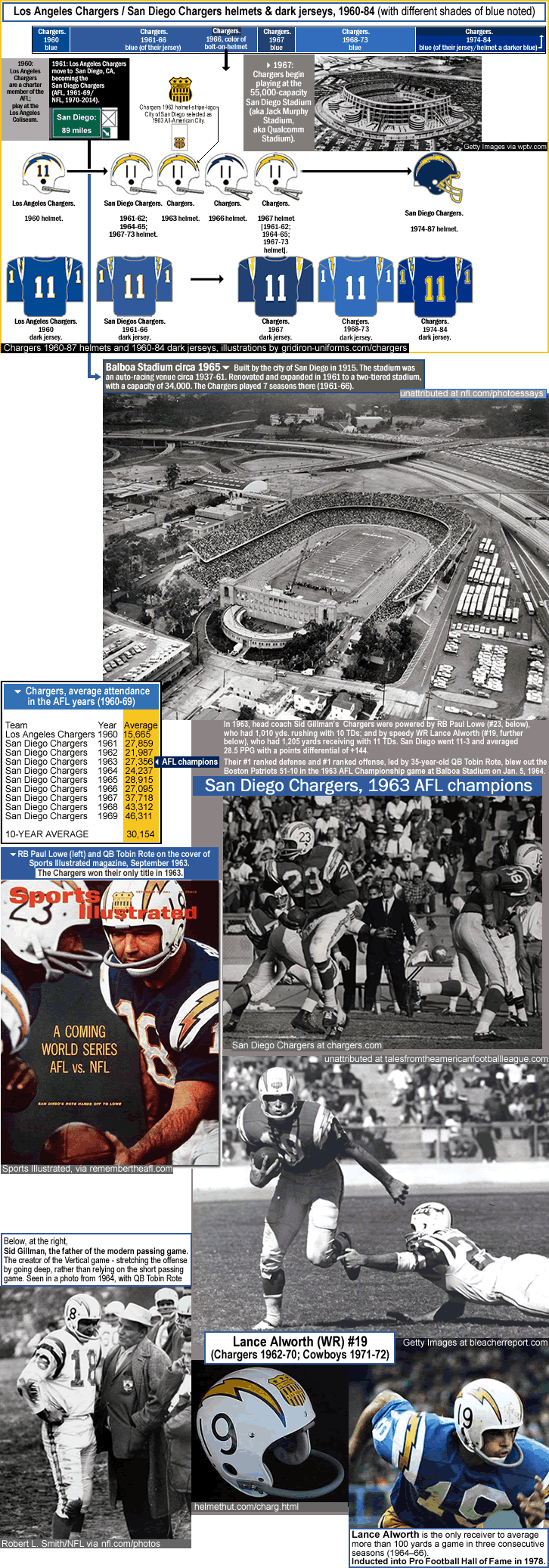
Photo and Image credits above -
Chargers 1960-73 helmets and 1960-84 jerseys, illustrations by gridiron-uniforms.com/chargers. Aerial photo of San Diego Stadium (Jack Murphy Stadium), photo by Getty Images via wptv.com/sports/qualcomm-conundrum-cracks-in-the-sidewalk. Aerial photo of Balboa Stadium circa 1965, photo unattributed at nfl.com/photoessays [San Diego Chargers]. Paul Lowe on a run, photo by San Diego Chargers at chargers.com/gallery/Chargers-to-Honor-1963-Championship-Team. Lance Alworth, b/w action photo unattributed at talesfromtheamericanfootballleague.com/lance-alworths-archive-chargers-home-jersey. Tobin Rote and Paul Lowe on the cover of Sports Illustrated, via remembertheafl.com. Sid Gillman and Tobin Rote on sideline, photo by Robert L. Smith/NFL via nfl.com/photos. Photo of Chargers’ Lance Alworth 1963 helmet (All American badge year) (Authentic Reproduction), by http://www.helmethut.com/charg.html . Lance Alworth, color photo by Getty Images at at bleacherreport.com/articles/1198408-the-50-best-teams-in-nfl-history.
San Diego Stadium/Jack Murphy Stadium/Qualcomm Stadium – home of the Chargers since 1967…
The new stadium that opened in 1967 was built by the city of San Diego. The Chargers played the first game ever at the stadium on August 20, 1967. San Diego Stadium was renamed Jack Murphy Stadium in 1980, in honor of local sportswriter Jack Murphy, who was instrumental, circa the mid-1960s, in getting the stadium built (since 1997 it has been called Qualcomm Stadium). The stadium was also home of the San Diego Padres. The Padres of the National League played there from 1969-2003 (they now play in their own purpose-built ballpark, Petco Park).
…
-
Colors and helmet-logos of the Chargers…
1960 – Dark “Collegiate Blue” and Yellow/Gold (white helmet with arc-shaped-lightning-bolt logo in blue-with-yellow-outline)…
Collegiate Blue is basically dark-sky-blue (or dark powder-blue). I actually could not find any reason why Barron Hilton chose dark-powder-blue and yellow/gold as his football team’s colors. But I am going to go out on a limb and just say it…he was copying one of Los Angeles’ two big college teams’ colors – the UCLA Bruins football team wears powder-blue and gold. After all, Hilton had already copied from another…in naming the team the Chargers, Hilton had partially borrowed an aspect of the other big college football team in town, the USC Trojans, with their bugle-spurred cry of “Charge!” [see origins of Chargers nickname section further above]). Their first year in LA found the Chargers in a pretty dark shade of collegiate blue, with the white helmet’s arced-lightning-bolt logo in blue-with-yellow-outline (the numbers were also in these two colors) {1960 Los Angeles Chargers helmet (helmethut.com)}. The Chargers were the first pro football team to have a logo-design incorporated into their pants-stripe…a lightning bolt, of course (you can see the whole history of the Chargers’ pants-stripe logos in the Chargers logos and helmet-history illustration at the top of the Chargers section here {or here}. The lightning-bolt logo on their white helmet was revised (and perfected) the following year when the team moved down to San Diego.
1961-66 – Collegiate Blue and Yellow/Gold (white helmet with arc-shaped-lightning-bolt logo in yellow-with-black-outline)…
{HoF OT Ron Mix (and the rest of the Chargers’ offensive line) in the 1961-65 Chargers dark-jersey gear [photo from either 1964 or 1965].}
{1961 Chargers uniforms.} Upon the move to San Diego, the Collegiate blue was now a shade lighter – appropriate in that the very bright blue evokes San Diego’ pleasant weather and sea-side charm. (You can see the difference between the 1960 and 1961 Chargers’ powder-blue in the illustration a couple paragraphs above). The helmet now featured what has become the iconic Chargers helmet – a white helmet with a grey facemask, an arced-lightning-bolt logo in yellow-with-black outline, and the player’s number, under the bolt-logo, in a black sans-serif font. Sheer perfection. The keys to the brilliance of this helmet design is the combination of all the negative space in the helmet with the bold arc of the lightning-bolt logo…and the black outline and the black number under the bolt. There is no other black in the Chargers color-scheme, but for some reason it is so appropriate there as a trim color on the helmet. The black, especially the black number, somehow pulls it all together (and you can see what I mean about that when you look at all the other color-variations of the arced-lightning-bolt logo…they all seem lacking somehow). The fact that lightning bolts are never curved in nature, but are on the Chargers helmet, is a point often overlooked. But the curve-in-the-lightning-bolt is why I think the Chargers bolt logo is so much better than Air Force Academy’s football helmet logo {here}…the curve of the Chargers’ bolt follows the curve of the football helmet itself so it becomes more cohesive. When you combine this stunning and eye-catching helmet-design with the Chargers’ powder-blue and gold in the jersey and pants, well, it just does not get any better. In my opinion the San Diego Chargers’ 1961 helmet is the greatest helmet-design in the history of gridiron football. Of course, after years of widespread fan-acclaim during periods of NFL throwback uniforms, the modern-day Chargers refused to bow to public pressure and simply re-adopt this helmet-design, and just had to mess with it (why?), by making the facemask navy blue (why?) and getting rid of the player’s number (why?) and screwing around with the lightning-bolt logo by ditching the black and having the yellow bolt now be trimmed with an overly-busy combo of powder-blue and navy-blue. But I digress. The 1961 Chargers helmet was used these years: 1961-65; 1967-73; 1994 [throwback uniform]; 2002-06 [throwback uniform]; 2009 [throwback uniform].
1966 – Collegiate Blue and Yellow/Gold (white helmet with arc-shaped-lightning-bolt logo in dark-blue)…
The Chargers front office messed with the helmet-logo, making the lightning-bolt logo dark blue. That helmet did not look tougher, it looked neutered. {Here is Chargers RB Keith Lincoln in the 1966 Chargers helmet (the opposing team is wearing another mid-1960s helmet-fail [Denver Broncos 1965-66 pastel-red/orange-helmet-w/-goofy-horse-logo).} It lasted one year, and in 1967 it was back to the yellow-with-black-outline bolt (aka the 1961 Chargers helmet). The Chargers' yellow pants made their debut in 1966 (history of Chargers pants colors can be seen here).
1967 - Dark Collegiate Blue and Yellow/Gold (white helmet with arc-shaped-lightning-bolt logo in yellow-with-black-outline)...
1961-style classic bolt helmet is back. This time the front office messes with the jerseys, making the powder-blue much darker, so the 1967 Chargers sported Dark Collegiate Blue {here}. That color just seems off. It belongs on upscale dinnerware or guest-bathroom walls, not football gear. In the photo at the following link, of QB John Hadl at the new San Diego Stadium in 1967, you can see how odd the color looks, especially because the socks are still light-powder-blue, but the jersey color looks like a mixture of navy-blue and sky-blue {here}.
1968-73 - Light Collegiate Blue and Yellow/Gold (white helmet with arc-shaped-lightning-bolt logo in dark-blue)...
Back to the light powder-blue first worn in 1961, now even brighter. The Chargers finally nail it down in this traffic-stopping uniform. The Chargers evoked even more of sunny southern California with their 1968-73 uniforms {here}. The '68-to-'73 jerseys had the lightest shade of powder-blue the Chargers ever used. The following link shows this style uniform in its last season...here is Johnny Unitas as Chargers' QB in one of his last 4 games in the NFL in 1973. These uniforms were worn by the Chargers for 6 seasons. It was too good to last...and it took mid-1970s sensibilities to kill this masterpiece.
1974-84 - Royal Blue and Yellow/Gold (dark-blue helmet with yellow facemask and arc-shaped lightning-bolt logo in yellow-with-dark-blue-and-white-outline)...
{Here is the great 'Bolts QB Dan Fouts in the 1974-to-'84 Chargers gear.} Dark royal blue replaces the bright-powder-blue; yellow pants remain. Helmets are also now dark royal blue, and are a darker shade of blue than the jerseys. Yellow facemasks, (which are, for the NFL, the first colored facemasks worn by the entire team), replace the grey facemasks. Interesting trivia...in 1978 and in 1983, the Chargers only wore their white jersey {1978 Chargers uniform; 1983 Chargers' uniform}.
When these uniforms came out in 1974, I was enthralled with them (yellow facemasks!; no more "boring" white helmets for the Chargers!). But what do 9-year-old kids know about good design? Heck, for that matter, what did the mid-1970s know about good design? The 1970s gave us such crimes against nature as burnt-orange shag rugs and avocodo-colored kitchen appliances (both of which featured in our household, and millions of other households, back then). Not counting white facemasks, aside from a couple of anomalies, the Chargers were the first NFL team to have a colored facemask (except for some players' helmets of the 1953 Chicago Cardinals {see this}, and except for some players helmets of the 1956 Baltimore Colts {here}. Now, well over half the NFL teams have colored facemasks (in 2014, 22 of the 32 teams in the NFL teams have colored facemasks on their primary helmet).
Colored facemasks have jumped the shark. Give me grey facemasks any day. Besides, why make it harder for your team? Why have colored facemasks, because all you are accomplishing (besides a gaudy look), is giving your team vision problems. If you play in a colored facemask, you are going to be visually impaired by being distracted by seeing that color all the time, instead of seeing fully what you really need to see...which is, what is going on in the field all around you. The first team to "see the light" and reverse the trend of colored facemasks was the New York Giants, who went back to grey facemasks in 2000. Now the Colts and the Bills and the 49ers and the Browns have also went back to grey facemasks in recent years [the only NFL teams that have only-ever worn grey facemasks are the Cowboys, the Raiders, and (beside that aforementioned exception in 1953), the Cardinals].
1985-87 – Dark Blue and Yellow/Gold (dark-blue helmet with yellow facemask and arc-shaped lightning-bolt logo in yellow-with-dark-blue-and-white-outline)…
{1985 Chargers uniforms}. The jerseys in this 3-year period became a darker shade of blue. Yellow pants were replaced by white pants, and those white pants featured a snazzy dark-blue-stripe-with-lightning-bolt-inside.
1988-2006 – Navy Blue and Yellow/Gold (navy-blue helmet with navy-blue facemask and arc-shaped lightning-bolt logo in white-with-dark-blue-and-yellow-outline)…
{1988 Chargers uniforms.} The Chargers made their blue even darker, to navy blue – on both the helmet and the home jersey. The yellow/gold was de-emphasized to only a minor trim color (even the lighning-bolt on the helmet was no longer yellow). In the third year of this design (1990), navy-blue pants were introduced. In 1994, the NFL’s 75th anniversary season, as part of their throwback uniforms for some games, the Chargers finally again wore their 1961-style white helmet-with-bolt-and-black-numbers {1994 Chargers}.
2007-14 – Navy Blue with Yellow/Gold and Collegiate Blue trim (white helmet with navy-blue facemask and revised-arc-shaped-3-color-lightning-bolt logo)…
{2007 Chargers uniforms.} As already mentioned, the Chargers sort of bowed to fan pressure and re-introduced the white helmet, but they basically took all the good elements out of the 1961 Chargers helmet-design – no number anymore, no grey facemask, no black trim-color. And the worst thing is they refuse to wear the 1961-style helmet anymore, with one exception, {2009 Chargers uniforms.} Bring back the 1961 Chargers helmet!
___
Many details in the post here come courtesy of pro football historian Bob Carroll’s epic and hilarious book about pro football in the 1960s, When the Grass Was Real – Unitas, Brown, Lombardi, Sayers, Butkus, Namath, and All the Rest: The Ten Best Years of Pro Football (Simon & Schuster, New York, 1993) {at amazon, here}.
Thanks to the contributors to the pages at en.wikipedia.org, ‘AFC West‘ (en.wikipedia.org).
Thanks to OSC forum, http://www.oursportscentral.com/boards/showthread.php?t=1789 for AFL-attendance-figures-text-blocks.
Special thanks to Tim Brulia, Bill Schaefer and Rob Holecko of The Gridiron Uniform Database, for giving billsportsmaps.com the permission to use the football uniforms illustrations (helmet illustrations and jersey/uniform illustrations), at gridiron-uniforms.com.



